|
What executives should remember
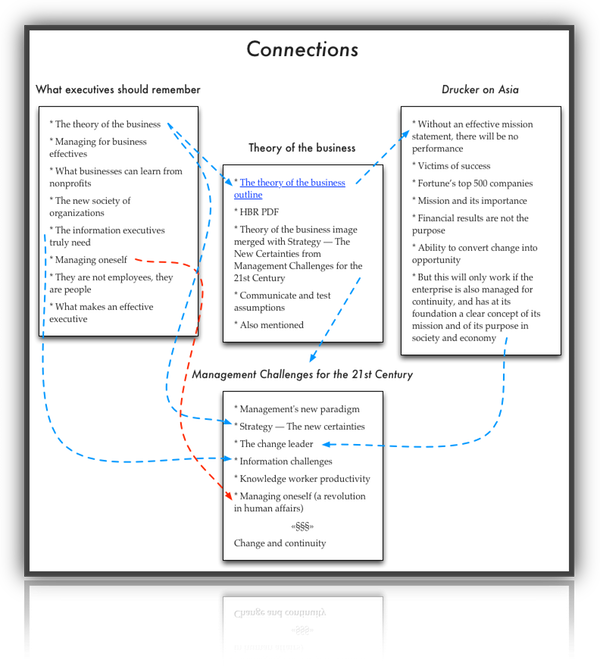
(core work toward)
“Management’s concern and management’s responsibility are everything
that affects the performance of the institution and
its results—whether inside or outside,
whether under the institution’s control
or totally beyond it.” — Management’s new paradigm
The change leader

Without the institution, there would be no management.
But without management, there would be only a mob rather than an institution.
(core work toward)
The institution is itself an organ of society and exists only to contribute a needed result to society, the economy, and the individual.
Organs, however, are never defined by what they do, let alone by how they do it.
They are defined by their contribution.
And it is management that enables the institution to contribute.
“The customer never buys what you think you sell.
And you don’t know it.
That’s why it’s so difficult to differentiate yourself.” — Drucker
§§§
All our experience tells us that the customer never buys what the supplier sells
Value to the customer is always something fundamentally different from what is value or quality to the supplier
This applies as much to a business as it applies to a university or to a hospital
See marketing
(core work toward)
Indeed, the first task of management is to define what results and performance are in a given organization — and this, as anyone who has worked on this task can testify, is in itself one of the most difficult, one of the most controversial, but also one of the most important tasks
It is, therefore, the specific function of management to organize the resources of the organization for results outside the organization
From chapter 44 of Management, Revised Edition
We no longer need to theorize about how to define performance and results in the large enterprise.
Rather, they maximize the wealth-producing capacity of the enterprise.
It is this objective that integrates short-term and long-term results and that ties the operational dimensions of business performance—market standing, innovation, productivity, and people and their development—to financial needs and financial results.
It is also this objective on which all constituencies depend for the satisfaction of their expectations and objectives, whether shareholders, customers, or employees.
To define performance and results as maximizing the wealth-producing capacity of the enterprise may be criticized as vague.
To be sure, one doesn’t get the answers by filling out forms.
Decisions need to be made, and economic decisions that commit scarce resources to an uncertain future are always risky and controversial.
Financial objectives are needed to tie all this together.
Indeed, financial accountability is the key to the performance of management and enterprise.
Without financial accountability, there is no accountability at all.
And without financial accountability, there will also be no results in any other area.
What we have is not the “final answer.”
Still, it is no longer theory but proven practice.
... snip, snip ...
For while the business audit need not be conducted every year (every three years may be enough in most cases), it needs to be based on predetermined standards and go through a systematic evaluation of business performance, starting with mission and strategy, through marketing, innovation, productivity, people development, community relations, all the way to profitability.
Still, the question remains, Who is going to use this tool?
In the American context, there is only one possible answer: a revitalized board of directors
(core work toward)
… Of course, it is always important to adapt to economic changes rapidly, intelligently, and rationally.
But managing implies responsibility
for attempting to shape the economic environment;
for planning, initiating, and carrying through changes in that economic environment;
for constantly pushing back the limitations of economic circumstances on the enterprise’s ability to contribute.
What is possible—the economist’s “economic conditions”—is therefore only one pole in managing a business.
What is desirable in the interest of economy and enterprise is the other.
And while humanity can never really “master” the environment, while we are always held within a tight vise of possibilities, it is management’s specific job to make what is desirable first possible and then actual.
Management is not just a creature of the economy; it is a creator as well.
And only to the extent to which it masters the economic circumstances, and alters them by consciously directed action, does it really manage.
To manage a business means, therefore, to manage by objectives
Chapter 3, Management, Revised Edition

The Management Revolution from Post-Capitalist Society
Supplying knowledge to find out how existing knowledge can best be applied to produce results is, in effect, what we mean by management.
But knowledge is now also being applied systematically and purposefully to define what new knowledge is needed, whether it is feasible, and what has to be done to make knowledge effective.
It is being applied, in other words, to systematic innovation.
Most people when they hear the word “management” still hear “business management.”
But we soon learned that management is needed in all modern organizations.
In fact, we soon learned that it is needed even more in organizations that are not businesses, whether not-for-profit but non-governmental organizations (what in this book I propose we call the “social sector”) or government agencies.
These organizations need management the most precisely because they lack the discipline of the “bottom line” under which business operates.
That management is not confined to business was recognized first in the United States.
But it is now becoming accepted in every developed country.
We now know that management is a generic function of all organizations, whatever their specific mission.
It is the generic organ of the knowledge society.
Management has been around for a very long time.
I am often asked whom I consider the best or the greatest executive.
My answer is always: “The man who conceived, designed, and built the first Egyptian Pyramid more than four thousand years ago—and it still stands.”
But management as a specific kind of work was not seen until after World War I—and then by just a handful of people.
Management as a discipline only emerged after World War II.
As late as 1950, when the World Bank began to lend money for economic development, the word “management” was not even in its vocabulary.
With this powerful expansion of management came a growing understanding of what management really means.
When I first began to study management, during and immediately after World War II, a manager was defined as “someone who is responsible for the work of subordinates.”
A manager in other words was a “boss,” and management was rank and power.
This is probably still the definition a good many people have in mind when they speak of “managers” and “management.”
But by the early 1950s, the definition of a manager had already changed to one who “is responsible for the performance of people.”
Today, we know that that is also too narrow a definition.
The right definition of a manager is one who “is responsible for the application and performance of knowledge.”
This change means that we now see knowledge as the essential resource.
Land, labor, and capital are important chiefly as restraints.
Without them, even knowledge cannot produce; without them, even management cannot perform.
But where there is effective management, that is, application of knowledge to knowledge, we can always obtain the other resources.
That knowledge has become the resource, rather than a resource, is what makes our society “post-capitalist.”
 This fact changes—fundamentally—the structure of society. This fact changes—fundamentally—the structure of society.
 It creates new social and economic dynamics. It creates new social and economic dynamics.
 It creates new politics. It creates new politics.

The Function Of Organizations
The function of organizations is to make knowledges productive.
Organizations have become central to society in all developed countries because of the shift from knowledge to knowledges.
The more specialized knowledges are, the more effective they will be.
The best radiologists are not the ones who know the most about medicine; they are the specialists who know how to obtain images of the body's inside through X-ray, ultrasound, body scanner, magnetic resonance.
The best market researchers are not those who know the most about business, but the ones who know the most about market research.
Yet neither radiologists nor market researchers achieve results by themselves; their work is “input” only.
It does not become results unless put together with the work of other specialists.
Knowledges by themselves are sterile.
They become productive only if welded together into a single, unified knowledge.
To make this possible is the task of organization, the reason for its existence, its function.
Peter Drucker, Post-Capitalist Society
In the knowledge society, it is not the individual who performs.
The individual is a cost center rather than a performance center.
It is the organization that performs.
(Across multiple time dimensions:
explore the life stories of HP, Kodak, RIM or RCA)
— A Century of Social Transformation by Peter Drucker

“The productivity of knowledge is going to be the determining factor
in the competitive position of a company, an industry, an entire country.
No country, industry, or company has any “natural” advantage or disadvantage.
The only advantage it can possess is the ability to exploit universally available knowledge.
The only thing that increasingly will matter
in national as in international economics
is management’s performance in making knowledge productive.”
— Knowledge: Its Economics and Productivity

Because the knowledge society
perforce has to be
a society of organizations,
its central and distinctive organ is
management.
When we first began to talk of management, the term meant “business management” — since large-scale business was the first of the new organizations to become visible.
But we have learned this last half-century that management is the distinctive organ of all organizations.
All of them require management—whether they use the term or not.
All managers do the same things whatever the business of their organization.
All of them have to bring people—each of them possessing a different knowledge—together for joint performance.
All of them have to make human strengths productive in performance and human weaknesses irrelevant.
(He is separating two different dimensions of individuals — their knowledges and their strengths)
All of them have to think through what are “results” in the organization—and have then to define objectives.
 How to guarantee non-performance How to guarantee non-performance
 Management by Objectives — a user’s guide Management by Objectives — a user’s guide
Find “objectives” on this page
All of them are responsible to think through what I call the “theory of the business,” that is, the assumptions on which the organization bases its performance and actions, and equally, the assumptions which organizations make to decide what things not to do (abandonment).
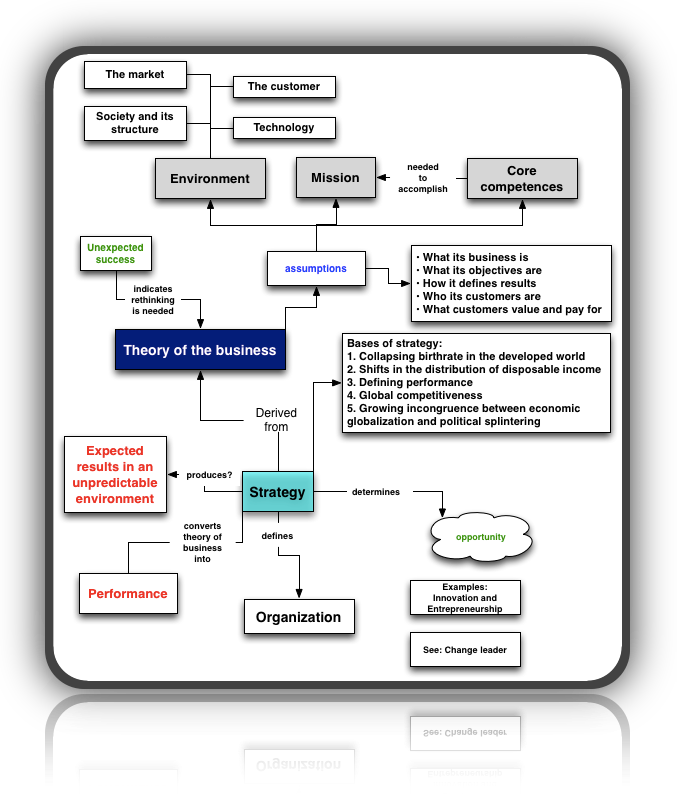
Communicate and Test Assumptions
The theory of the business must be known and understood throughout the organization.
This is easy in an organization’s early days.
But as it becomes successful, an organization tends increasingly to take its theory for granted, becoming less and less conscious of it.
Then the organization becomes sloppy.
It begins to cut corners.
It begins to pursue what is expedient rather than what is right.
It stops thinking.
It stops questioning.
It remembers the answers but has forgotten the questions.
The theory of the business becomes “culture.”
But culture is no substitute for discipline, and the theory of the business is a discipline.
The theory of the business has to be tested constantly.
It is not graven on tablets of stone.
It is a hypothesis.
And it is a hypothesis about things that are in constant flux—society, markets, customers, technology.
And so, built into the theory of the business must be the ability to change itself.
Some theories are so powerful that they last for a long time.
Eventually every theory becomes obsolete and then invalid.
It happened to the GMs and the AT&Ts.
It happened to IBM.
It is also happening to the rapidly unraveling Japanese keiretsu.
4 JUL The Daily Drucker
All of them require an organ that thinks through strategies, that is, the means through which the goals of the organization become performance.
All of them have to define the values of the organization, its system of rewards and punishments, and with its spirit and its culture.
In all of them, managers need both
the knowledge of management as work and discipline,
and
the knowledge and understanding of the organization itself
its purposes,
its values,
its environment and markets,
its core competencies.
— A Century of Social Transformation by Peter Drucker

Management and Entrepreneurship
… It should have been obvious from the beginning that management and entrepreneurship are only two different dimensions of the same task.
An entrepreneur who doesn’t learn how to manage will not last long.
A management that does not learn to innovate will not last long.
Every institution—and not only business—must build into its day-to-day management four entrepreneurial activities that run in parallel.
One is the organized abandonment of products, services, processes, markets, distribution channels and so on that are no longer an optimal allocation of resources.
This is the first entrepreneurial discipline in any given situation.
Then any institution must organize for systematic, continuing improvement (what the Japanese call kaizen).
Then it has to organize for systematic and continuous exploitation, especially of its successes.
It has to build a different tomorrow on a proven today.
And, finally, it has to organize systematic innovation, that is, to create the different tomorrow that makes obsolete and, to a large extent, replaces even the most successful products of today in any organization.
See innovation in the existing organization requires special effort
I emphasize that these disciplines are not just desirable, they are three conditions for survival today.
These entrepreneurial tasks differ from the more conventional management roles of allocating present-day resources to present-day demands.
These entrepreneurial activities start with the outside and are focused on the outside.
But the tools we originally fashioned to bring the outside to the inside have all been penetrated by the inside focus of management.
They have turned into tools to enable management to ignore the outside.
Even worse, they are used to make management believe it can manipulate the outside and turn it to the organization’s purpose.
Take marketing
The term was coined 50 years ago to emphasize that the purpose and results of a business lie entirely outside of itself.
Marketing teaches that organized efforts are needed to bring an understanding of the outside, of society, economy and customer, to the inside of the organization and to make it the foundation for strategy and policy.
Yet marketing has rarely performed that grand task.
Instead it has become a tool to support selling.
It does not start out with “who is the customer?” but “what do we want to sell?”
It is aimed at getting people to buy the things that you want to make.
That’s getting things backward.
American industry lost the fax machine business that way.
The question should be “how can I make things the customers want to buy.”
Executives of any large organization—whether business enterprise, Roman Catholic diocese, university, health care institution, government agency—are woefully ignorant of the outside, as everybody knows who has worked with decisions in a large organization.
These executives must spend too much of their time and energy managing inwardly rather than managing outwardly.
The inward focus of management has been aggravated rather than alleviated in the last decades by the rise of information technology.
Information technology so far may well have done serious damage to management because it is so good at getting additional information of the wrong kind.
Based upon the 700-year-old accounting system designed to record and report inside data, information technology produces more data about the inside.
It produces practically no information about anything that goes on outside of the enterprise.
Practically every conference on information deals exclusively with how to get more inside data.
I have yet to hear of one that even raises the question: “What outside data do we need, and how do we get them?”
Management does not need more information about what is happening inside.
It needs more information on what is happening outside.
So far no one has figured out how to get meaningful outside data in any systematic form.
When it comes to outside data, we are still very largely in the anecdotal stage.
It can be predicted that the main challenge to information technology in the next 30 years will be to organize the systematic supply of meaningful outside information.
It is understandable that management began as a concern for the inside.
When the first large, modern organizations first arose—around 1870—the first and by far the most visible need was to organize the enterprise itself.
Nobody had ever done it before on that scale.
But now we know how to do that.
Growth and survival both now depend on getting the organization in touch with the outside world.
Management has become an external, not an internal, task.
For results take place outside the organization.
Inside, there are only costs.

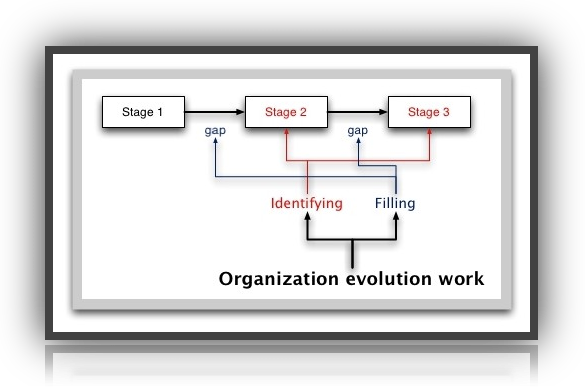
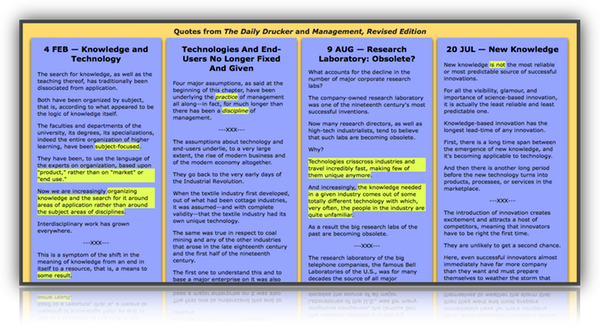
Larger
It is the very nature of knowledge
that it changes fast and
that today's certainties
will be tomorrow's absurdities. — Peter Drucker

Purpose and Objectives First
To Drucker, strategy, like everything else in management, is a thinking person’s game.
It isn’t arrived at by following some rigid set of rules but by thinking through various aspects of the business.
It all starts with objectives.
 How to guarantee non-performance How to guarantee non-performance
 Management by Objectives — a user's guide Management by Objectives — a user's guide
“Only a clear definition of the mission makes possible clear and realistic business objectives.
It is the foundation for priorities, strategies, plans and work assignments.
It is the starting point for the design of managerial jobs, and, above all, for the design of managerial structures.
Structure follows strategy.
Strategy determines what the key activities are in a given business.
And strategy requires knowing what our business is and what it should be.
Chapters on “What is a Business” and “Business Purpose and Business Mission” in Management: Tasks, Responsibilities, Practices and Chapters 8 and 9 in Management, Revised Edition
Drucker also explained that “nothing may seem simpler or more obvious than to answer what a company’s business is.
A steel mill makes steel, a railroad runs to carry freight and passengers … .
Actually ‘what is our business?’ is almost always a difficult question which can be answered only after hard thinking and studying.
And the right answer is usually anything but obvious.”
Thinking back to Drucker’s Law, no strategy can be created without the customer, for it is the customer who defines business purpose.
And “therefore the question ‘what is our business?’ can be answered only by looking at the business from the outside, from the point of view of the customer and the market.
What the customer sees, thinks, believes and wants at any given time must be accepted by management as an objective fact deserving to be taken as seriously” as any hard data collected from salespeople, accountants, or engineers, contended Drucker.
Drucker claimed that the single most important cause of business failure can be attributed to management’s failure to ask the question “what is our business?” in a “clear and sharp form.”
And it isn’t only when a company is starting out that the question should be asked, or when the company is in trouble.
“On the contrary,” Drucker wrote, “to raise the question and to study it thoroughly is most needed when a business is successful.
For then failure to raise it may result in rapid decline.”
— Inside Drucker's Brain
A product or service name is never an effective answer to these questions because it doesn’t specify the specific contribution to the customer that matches what customers value and pay for — they buy what it does for them. See “The Customer: Joined at the Hip” in The Definitive Drucker and “Changing Values and Characteristics (creating a customer)” in Innovation and Entrepreneurship — bobembry

See Chapter 44
“The Impact of Pension Funds on Corporate Governance” in
Management, Revised Edition

Analysis of the entire business and its basic economics always shows it to be in worse disrepair than anyone expected.
The products everyone boasts of turn out to be yesterday’s breadwinners or investments in managerial ego.
Activities to which no one paid much attention turn out to be major cost centers and so expensive as to endanger the competitive position of the company.
What everyone in the business believes to be quality turns out to have little meaning to the customer.
Important and valuable knowledge either is not applied where it could produce results or produces results no one uses.
I know more than one executive who fervently wished at the end of the analysis that he could forget all he had learned and go back to the old days of the “rat race” when “sufficient unto the day was the crisis thereof.”
But precisely because there are so many different areas of importance, the day-by-day method of management is inadequate even in the smallest and simplest business.
Because deterioration is what happens normally—that is, unless somebody counteracts it—there is need for a systematic and purposeful program.
There is need to reduce the almost limitless possible tasks to a manageable number.
There is need to concentrate scarce resources on the greatest opportunities and results.
There is need to do the few right things and do them with excellence.
Managing for Results by Peter Drucker
Broken Washroom Doors: Drucker said the problem of having people in positions where they do the least amount of good exists everywhere, but it is more rampant in hospitals, churches, and other nonprofits than in corporations.
To raise productivity in most any organization managers should regularly assess their key people, their strengths, and the results they achieve.
Then they should ask themselves:
Do we have the right people in the right jobs, where they can make the greatest contributions?
Are the jobs the right ones, meaning do we have people performing tasks that even if achieved do not add value to the organization?
What changes in people, jobs, and job functions can we make that will yield greater results?
Inside Drucker's Brain
The 90/10 Rule at Yum! Brands
But every analysis of actual allocation of resources and efforts in business that I have ever seen or made showed clearly that the bulk of time, work, attention, and money first goes to 'problems' rather than to opportunities, and, secondly, to areas where even extraordinarily successful performance will have minimal impact on results. (calendarize this?)
One of the hardest things for a manager to remember is that of the 1,000 different situations he or she will be asked to deal with on any given day, only the smallest handful have a shot at moving the enterprise forward in a truly significant way (calendarize this?)
The job of management, then, is to make sure that financial capital, technology, and top talent are deployed where most of the results are and where most of the costs aren't. The temptation often exists, however, to do exactly the opposite
High tech is living in the nineteenth century, the pre-management world. They believe that people pay for technology. They have a romance with technology. But people don't pay for technology: they pay for what they get out of technology. The Frontiers of Management

Many highly intelligent people use their thinking
to back up or defend their immediate judgement of a matter.
… a perception-broadening tool (attention-directing)
forces a thinker to explore the situation
before coming to a judgement — Edward de Bono

“To know something,
to really understand something important,
one must look at it from sixteen different angles.
People are perceptually slow,
and there is no shortcut to understanding;
it takes a great deal of time.” read more
Attention directing is exploring
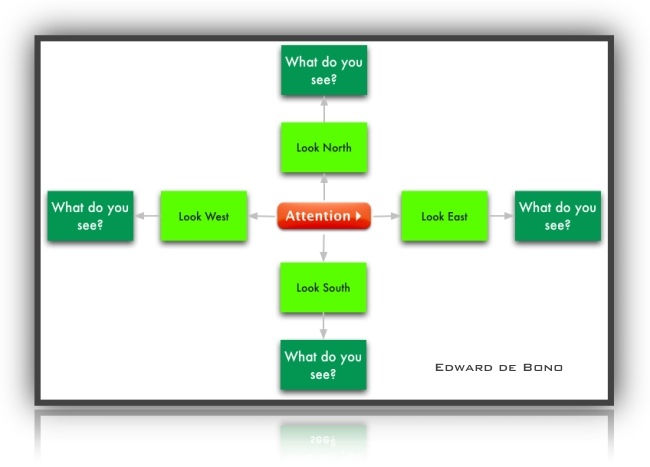
Questions are attention directing tools
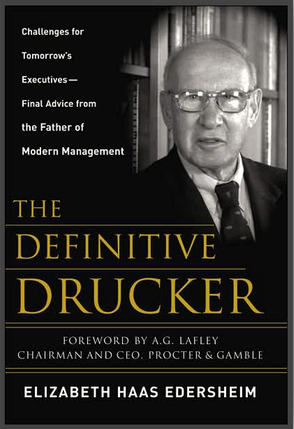
Questions in The Definitive Drucker.
Social ecologists try to find the right questions
Using your ignorance to your benefit
What impact might an educated person add to the thinking?
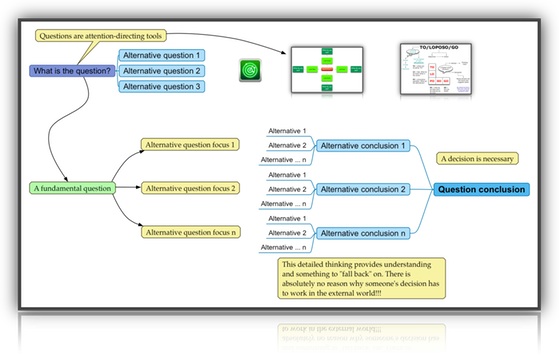
Larger
Effectively working on questions
requires a
foundation for future directed decisions

Sometimes alternative answers
need to be combined
to create an effective “constellation.”
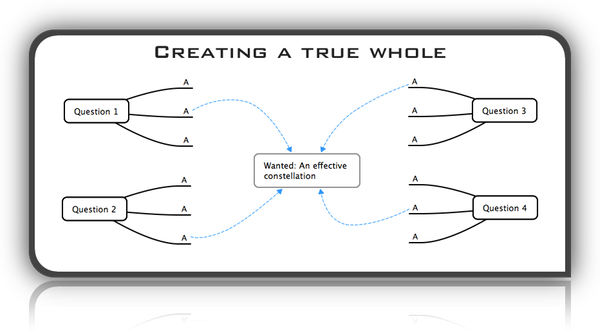
Larger

Dense reading and Dense listening
A tool for harvesting, collecting, and organizing “information”

Larger ::: Scrivener
Larger view of challenge thinking and an alternative — operacy
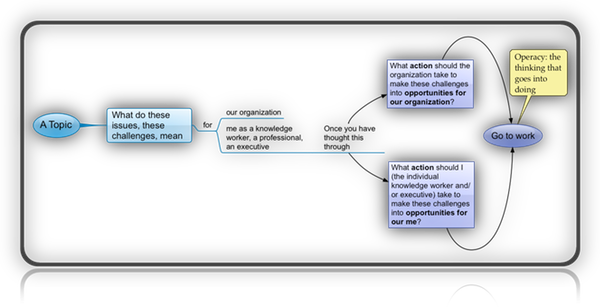
Dense reading and Dense listening
and Thinking broad and Thinking detailed
by Edward de Bono
Google site search: asking right questions
See Drucker books for more questions

The view of management presented above is the opposite of inside-out behavior …
AS WE ADVANCE deeper into the knowledge economy, the basic assumptions underlying much of what is taught and practiced in the name of management are hopelessly out of date. (calendarize this?)
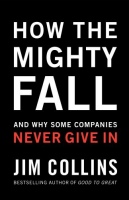
Amazon link: How The Mighty Fall

Only the Paranoid Survive
… the organization of the post-capitalist society of organizations
is a destabilizer.
Because its function is to put knowledge to work
—on tools, processes, and products;
on work;
on knowledge itself—
it must be organized for constant change.
It must be organized for innovation;
and innovation,
as the Austro-American economist
Joseph Schumpeter (1883-1950) said,
is “creative destruction.”
It must be organized for systematic abandonment
of the established, the customary, the familiar,
the comfortable
— whether products, services, and processes,
human and social relationships, skills,
or organizations themselves.
It is the very nature of knowledge
that it changes fast and
that today's certainties
will be tomorrow's absurdities. — Peter Drucker

What Is Management?
From Management, Revised Edition
But what is management?
Is it a bag of techniques and tricks?
A bundle of analytical tools like those taught in business schools?
These are important, to be sure, just as a thermometer and anatomy are important to the physician.
But the evolution and history of management—its successes as well as its problems—teach that management is, above all else, a very few, essential principles.
To be specific:
Management is about human beings.
Its task is to make people capable of joint performance, to make their strengths effective and their weaknesses irrelevant. See chapter 27 — The Spirit of Performance
This is what organization is all about, and it is the reason that management is the critical, determining factor.
These days practically all of us, especially educated people, are employed by managed institutions, large and small, business and nonbusiness.
We depend on management for our livelihoods.
And our ability to contribute to society also depends as much on the management of the organization in which we work as it does on our own skills, dedication, and effort.
Because management deals with the integration of people in a common venture, it is deeply embedded in culture.
What managers do in West Germany, in Britain, in the United States, in Japan, or in Brazil is exactly the same.
How they do it may be quite different.
Thus one of the basic challenges managers in a developing country face is to find and identify those parts of their own tradition, history, and culture that can be used as management building blocks.
The difference between Japan’s economic success and India’s relative backwardness is largely explained by the fact that Japanese managers were able to plant imported management concepts in their own cultural soil and make them grow.
Every enterprise requires commitment to common goals and shared values.
Without such commitment, there is no enterprise.
There is only a mob.
The enterprise must have simple, clear, and unifying objectives.
The mission of the organization has to be clear enough and big enough to provide common vision.
The goals that embody it have to be clear, public, and constantly reaffirmed.
Management’s first job is to think through, set, and exemplify those objectives, values, and goals.
 How to guarantee non-performance How to guarantee non-performance
 What Results Should You Expect? — A Users' Guide to MBO What Results Should You Expect? — A Users' Guide to MBO
 The Five Most Important Questions You Will Ever Ask About Your Organization The Five Most Important Questions You Will Ever Ask About Your Organization
Management must also enable the enterprise and each of its members to grow and develop as needs and opportunities change.
Every enterprise is a learning and teaching institution.
Training and development must be built into it on all levels—training and development that never stop.
Every enterprise is composed of people with different skills and knowledge doing many different kinds of work.
It must be built on communication and on individual responsibility.
All members need to think through what they aim to accomplish—and make sure that their associates know and understand that aim.
All have to think through what they owe to others—and make sure that others understand.
All have to think through what they, in turn, need from others—and make sure that others know what is expected of them.
Neither the quantity of output nor the “bottom line” is by itself an adequate measure of the performance of management and enterprise.
Market standing, innovation, productivity, development of people, quality, financial results—all are crucial to an organization’s performance and to its survival.
Nonprofit institutions, too, need measurements in a number of areas specific to their mission.
Just as a human being needs a diversity of measures to assess its health and performance, an organization needs a diversity of measures to assess its health and performance.
Performance has to be built into the enterprise and its management; it has to be measured—or at least judged—and it has to be continuously improved.
Finally, the single most important thing to remember about any enterprise is that results exist only on the outside.
The result of a business is a satisfied customer.
The result of a hospital is a healed patient.
The result of a school is a student who has learned something and puts it to work ten years later.
Inside an enterprise, there are only costs.
Managers who understand these principles and manage themselves in their light will be achieving, accomplished managers.
Management As A Liberal Art
Thirty years ago, the English scientist and novelist C. P. Snow talked of the “two cultures” of contemporary society.
Management, however, fits neither Snow’s “humanist” nor his “scientist.”
It deals with action and application; and its test is its results.
This makes it a technology.
But management also deals with people, their values, their growth and development—and this makes it a humanity.
So does its concern with and impact on social structure and the community.
Indeed, as has been learned by everyone who, like this author, has been working with managers of all kinds of institutions for long years, management is deeply involved in spiritual concerns—the nature of man, good and evil.
Management is thus what tradition used to call a liberal art:
“liberal” because it deals with the fundamentals of knowledge, self-knowledge, wisdom, and leadership;
“art” because it is practice and application.
Managers draw on all the knowledge and insights of the humanities and the social sciences—on psychology and philosophy, on economics and history, on ethics as well as on the physical sciences.
But they have to focus this knowledge on effectiveness and results—on healing a sick patient, teaching a student, building a bridge, designing and selling a “user-friendly” software program.
For these reasons, management will increasingly be the discipline and the practice through and in which the “humanities” will again acquire recognition, impact, and relevance.
Drucker’s Lost Art of Management: Peter Drucker’s Timeless Vision for Building Effective Organizations
Management, that is, the “useful knowledge” that enables man for the first time to render productive people of different skills and knowledge working together in an “organization,” is an innovation of this century.
It has converted modern society into something brand new, something, by the way, for which we have neither political nor social theory: a society of organizations. — Peter Drucker, Innovation and Entrepreneurship
For the first time in thousands of years, we face again a situation that can be compared with what our remote ancestors faced at the time of the irrigation civilization.
It is not only the speed of technological change that creates a revolution, it is its scope as well.
Above all, today, as seven thousand years ago, technological developments from a great many areas are growing together to create a new human environment.
This has not been true of any period between the first technological revolution and the technological revolution that got under way two hundred years ago and has still clearly not run its course. — Peter Drucker, Technology, Management and Society
… It also follows that managing a business must be a creative rather than an adaptive task. The more a management creates economic conditions or changes them rather than passively adapts to them, the more it manages the business — Management: Tasks, Responsibilities, Practices
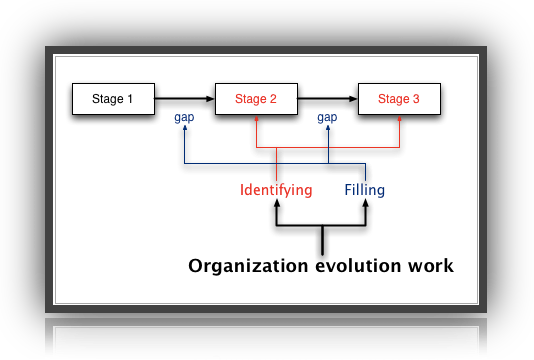
Organization evolution
Following is from Adventures of a Bystander
The knowledge society into which we are moving so fast is going to be a society of organizations.
But of organizations—plural—that will be diverse, decentralized, multiform.
And within these organizations, we are moving away from the standardized, uniform structures that were generally accepted in public administration and business management, “the one right structure for the typical manufacturing company,” for instance, or the “model government agency.”
We are moving toward organic design, informed by mission, purpose, strategy, and the environment, both social and physical—the design I began to advocate forty years ago in The Practice of Management (which came out in 1954). …
Sidebar: … to pursue the preceding line of thought
see Management’s New Paradigm
… the center of a modern society, economy and community is not technology.
It is not information.
It is not productivity.
The center of modern society is the managed institution.
The managed institution is society’s way of getting things done these days.
And management is the specific tool, the specific function, the specific instrument, to make institutions capable of producing results.
The institution, in short, does not simply exist within and react to society.
It exists to produce results on and in society.
… and Management, Revised Edition which contains a similarly named chapter with a different “landscape” a.k.a. “brainscape.”
Management Cases (Revised Edition) provides a more day-to-day, issue-to-issue, situational “landscape” view.
Also “From Analysis to Perception — The New World View” found in The New Realities or The Essential Drucker.
Form and Function Connections: see chapters On Being the Right Size and On Being the Wrong Size in Management: Tasks, Responsibilities, Practices and others. (calendarize this?)

Creativity from Chapter 10 of Management, Revised Edition
Try a MRE page search for the word stem “creat”
To make the future happen one need not, in other words, have a creative imagination.
It requires work rather than genius—and therefore is accessible in some measure to everybody.
The man of creative imagination will have more imaginative ideas, to be sure.
But that the more imaginative idea will actually be more successful is by no means certain.
Pedestrian ideas have at times been successful;
Bata’s idea of applying American methods to making shoes was not very original in the Europe of 1920, with its tremendous interest in Ford and his assembly line.
What mattered was his courage rather than his genius.
To make the future happen one has to be willing to do something new.
One has to be willing to ask,
“What do we really want to see happen that is quite different from today?”
One has to be willing to say,
“This is the right thing to happen as the future of the business.
We will work on making it happen.”
Lack of “creativity,” which looms so large in present discussions of innovation, is not the real problem.
There are more ideas in any organization, including businesses, than can possibly be put to use.
What is lacking, as a rule, is the willingness to look beyond products to ideas.
[See Sur/petition]
Products and processes are only the vehicle through which an idea becomes effective.
See piloting and strategies
Dense reading and Dense listening and Thinking broad and Thinking detailed
And, as the illustrations should have shown, the specific future products and processes can usually not even be imagined.
When DuPont started the work on polymer chemistry out of which nylon eventually evolved, it did not know that man-made fibers would be the end product.
DuPont acted on the assumption that any gain in man’s ability to manipulate the structure of large, organic molecules—at that time in its infancy—would lead to commercially important results of some kind.
Only after six or seven years of research work did man-made fibers first appear as a possible major result area.
Moreover, the manager often lacks the courage to commit resources to such an idea.
The resources that should be invested in making the future happen should be small, but they must be of the best.
Otherwise nothing happens.
However, the greatest lack of the manager is a touchstone of validity and practicality.
An idea has to meet rigorous tests if it is to be capable of making the future of a business.
It has to have operational validity.
Can we take action on this idea?
Or can we only talk about it?
Can we really do something right away to bring about the kind of future we want to make happen?
To be able to spend money on research is not enough.
It must be research directed toward the realization of the idea.
The knowledge sought may be general, as was that of DuPont’s project.
But it must at least be reasonably clear that if available, it would be applicable knowledge.
The idea must also have economic validity.
If it could be put to work right away in practice, it should be able to produce economic results.
We may not be able to do what we would like to for a long time, perhaps never.
But if we could do it now, the resulting products, processes, or services would find a customer, a market, an end-use; should be capable of being sold profitably; should satisfy a want and a need.
The idea itself might aim at social reform.
But unless an organization can be built on it, it is not a valid entrepreneurial idea.
The test of the idea is not the votes it gets or the acclaim of the philosophers.
It is economic performance and economic results.
Even if the rationale of the business is social reform rather than business success, the touchstone must be the ability to perform and to survive as a business.
Finally, the idea must meet the test of personal commitment.
Do we really believe in the idea?
Do we really want to be that kind of people, do that kind of work, run that kind of business?
To make the future demands courage.
It demands work.
But it also demands faith.
To commit ourselves to the expedient is simply not practical.
It will not suffice for the tests ahead.
For no such idea is foolproof—nor should it be.
The one idea regarding the future that must inevitably fail is the apparently “sure thing,” the “riskless idea,” the one “that cannot fail.”
The idea on which tomorrow’s business is to be built must be uncertain; no one can really say as yet what it will look like if and when it becomes reality.
It must be risky:
it has a probability of success but also of failure.
If it is not both uncertain and risky, it is simply not a practical idea for the future.
For the future itself is both uncertain and risky.
Unless there is personal commitment to the values of the idea and faith in them, the necessary efforts will therefore not be sustained.
The manager should not become an enthusiast, let alone a fanatic.
She should realize that things do not happen just because she wants them to happen—not even if she works very hard at making them happen.
Like any other effort, the work on making the future happen should be reviewed periodically to see whether continuation can still be justified both by the results of the work to date and by the prospects ahead.
Ideas regarding the future can become investments in managerial ego too, and need to be carefully tested for their capacity to perform and to give results.
But the people who work on making the future also need to be able to say with conviction, “This is what we really want our business to be.”
It is perhaps not absolutely necessary for every organization to search for the idea that will make the future.
A good many organizations and their managements do not even make their present organizations effective—and yet the organizations somehow survive for a while.
The big business, in particular, seems to be able to coast a long time on the courage, work, and vision of earlier managers.
But tomorrow always arrives.
It is always different.
And then even the mightiest company is in trouble if it has not worked on the future.
It will have lost distinction and leadership—all that will remain is big-company overhead.
It will neither control nor understand what is happening.
Not having dared to take the risk of making the new happen, it perforce took the much greater risk of being surprised by what did happen.
And this is a risk that even the largest and richest organization cannot afford and that even the smallest one need not run.
To be more than a slothful steward of the talents in one’s keeping, the manager has to accept responsibility for making the future happen.
It is the willingness to tackle this purposefully that distinguishes the great organization from the merely competent one, and the organization builder from the manager-suite custodian.
 A scorecard for managers A scorecard for managers
 Company performance: five telltale tests Company performance: five telltale tests
 Without an effective mission statement, there will be no performance Without an effective mission statement, there will be no performance
 Continuity and change Continuity and change
 Look Look
 Management Challenges for the 21st Century Management Challenges for the 21st Century
 Making the future Making the future
 Managing in the Next Society Managing in the Next Society

DESPITE its crucial importance, its high visibility and its spectacular rise, management is the least known and the least understood of our basic institutions.
Even the people in a business often do not know what their management does and what it is supposed to be doing, how it acts and why, whether it does a good job or not.
Indeed, the typical picture of what goes on in the “front office” or on “the fourteenth floor” in the minds of otherwise sane, well-informed and intelligent employees (including, often, people themselves in responsible managerial and specialist positions) bears striking resemblance to the medieval geographer’s picture of Africa as the stamping ground of the one-eyed ogre, the two-headed pygmy, the immortal phoenix and the elusive unicorn.
What then is management: What does it do?
The Practice of Management
A lot of people are confused by the word management.
Many assume or think that being given the title of manager instantly makes one a manager.
If that were the case how do we distinguish between those who actually manage and those who just have the title?
Also how do we differentiate between those in healthy, well performing institutions and sick institutions?
Despite all the outpouring of management writing these last twenty-five years, the world of management is still little-explored.
It is a world of issues, but also a world of people.
And it is undergoing rapid change right now.
These essays explore a wide variety of topics.
They deal with changes in the work force, its jobs, its expectations, with the power relationships of a “society of employees,” and with changes in technology and in the world economy.
They discuss the problems and challenges facing major institutions, including business enterprises, schools, hospitals, and government agencies.
They look anew at the tasks and work of executives, at their performance and its measurement and at executive compensation.
However diverse the topics, all the pieces reflect upon the same reality: In all developed countries the workaday world has become a “society of organizations” and thus dependent on executives, that is on people—whether called managers or administrators—who are paid to direct organizations and to make them perform.
These chapters have one common theme: the changing world of the executive —
changing rapidly within the organization;
changing rapidly in respect to the visions, aspirations, and even characteristics of employees, customers, and constituents;
changing outside the organization as well—economically, technologically, socially, politically.
The Changing World of The Executive

The Future of Top Management
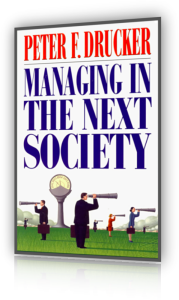
Amazon Link: Managing in the Next Society
As the corporation moves toward a confederation or a syndicate, it will increasingly need a top management that is separate, powerful, and accountable.
This top management’s responsibilities will cover the entire organization’s
direction, planning, strategy, values, and principles;
its structure and its relationship between its various members;
its alliances, partnerships, and joint ventures; and its research, design, and innovation.
It will have to take charge of the management of the two resources common to all units of the organization: key people and money.
It will represent the corporation to the outside world and maintain relationships with governments, the public, the media, and organized labor.
Life at the Top
An equally important task for top management in the Next Society’s corporation will be to balance the three dimensions of the corporation: as an economic organization, as a human organization, and as an increasingly important social organization.
Each of the three models of the corporation developed in the past half-century stressed one of these dimensions and subordinated the other two.
The German model of the “social market economy” put the emphasis on the social dimension, the Japanese one on the human dimension, and the American one (“shareholder sovereignty”) on the economic dimension.
None of the three is adequate on its own.
The German model achieved both economic success and social stability, but at the price of high unemployment and dangerous labor-market rigidity.
The Japanese model was strikingly successful for twenty years, but faltered at the first serious challenge; indeed it has become a major obstacle to recovery from Japan’s present recession.
Shareholder sovereignty is also bound to flounder.
It is a fair-weather model that works well only in times of prosperity.
Obviously the enterprise can fulfill its human and social functions only if it prospers as a business.
But now that knowledge workers are becoming the key employees, a company also needs to be a desirable employer to be successful.
Paradoxically, the claim to the absolute primacy of business gains that made shareholder sovereignty possible has also highlighted the importance of the corporation’s social function.
The new shareholders whose emergence since 1960 or 1970 produced shareholder sovereignty are not “capitalists.”
They are employees who own a stake in the business through their retirement and pension funds.
By 2000, pension funds and mutual funds had come to own the majority of the share capital of America’s large companies.
This has given shareholders the power to demand short-term rewards.
But the need for a secure retirement income will increasingly focus on people’s minds on the future value of the investment.
Corporations, therefore, will have to pay attention both to their short-term business results and to their long-term performance as providers of retirement benefits.
The two are not irreconcilable, but they are different, and they will have to be balanced.
Over the past decade or two, managing a large corporation has changed out of all recognition.
That explains the emergence of the “CEO superman,” such as Jack Welch of GE, Andrew Grove of Intel, or Sanford Weill of Citigroup.
But organizations cannot rely on supermen to run them; the supply is both unpredictable and far too limited.
Organizations survive only if they can be run by competent people who take their job seriously.
That it takes genius today to be the boss of a big organization clearly indicates that top management is in crisis.
Impossible Jobs
The recent failure rate of chief executives in big American companies points in the same direction.
A large proportion of CEOs of such companies appointed in the past ten years were fired as failures within a year or two.
But each of these people had been picked for his proven competence, and each had been highly successful in his previous jobs.
This suggests that the jobs they took on had become un-doable.
The American record suggests not human failure but systems failure.
Top management in big organizations needs a new concept.
Some elements of such a concept are beginning to emerge.
For instance, Jack Welch at GE has built a top-management team in which the company’s chief financial officer and its chief human resources officer are near equals to the chief executive and are both excluded from the succession to the top job.
He has also given himself and his team a clear and publicly announced priority task on which to concentrate.
During his twenty years in the top job, Mr. Welch has had three such priorities, each occupying him for five years or more.
Each time he has delegated everything else to the top managements of the operating businesses within the GE confederation.
A different approach has been taken by Asea Brown Boveri (ABB), a huge Swedish-Swiss engineering multinational.
Goran Lindahl, who retired as chief executive earlier this year, went even further than GE in making the individual units within the company into separate worldwide businesses and building up a strong top-management team of a few nonoperating people.
But he also defined for himself a new role as a one-man information system for the company, traveling incessantly to get to know all the senior managers personally, listening to them and telling them what went on within the organization.
A largish financial services company tried another idea: appointing not one CEO but six.
The head of each of the five operating businesses is also CEO for the whole company in one top-management area, such as corporate planning and strategy or human resources.
The company’s chairman represents the company to the outside world and is also directly concerned with obtaining, allocating, and managing capital.
All six people meet twice a week as the top management committee.
This seems to work well, but only because none of the five operating CEOs wants the chairman’s job; each prefers to stay in operations.
Even the man who designed the system, and then himself took the chairman’s job, doubts that the system will survive once he is gone.
In their different ways, the top people at all of these companies were trying to do the same thing: to establish their organization’s unique personality.
And that may well be the most important task for top management in the Next Society’s big organizations.
In the half-century after the Second World War, the business corporation has brilliantly proved itself as an economic organization, i. e., a creator of wealth and jobs.
In the Next Society, the biggest challenge for the large company—especially for the multinational—may be its social legitimacy: its values, its mission, its vision.
Increasingly, in the Next Society’s corporation, top management will, in fact, be the company.
Everything else can be outsourced.
Will the corporation survive?
Yes, after a fashion.
Something akin to a corporation will have to coordinate the Next Society’s economic resources.
Legally and perhaps financially, it may even look much the same as to day’s corporation.
But instead of there being a single model adopted by everyone, there will be a range of models to choose from.
And there equally will be a number of top-management models to choose from.
This might be a good stopping point
for a first read

Management is a (the) most special concept—a most special positive concept.
In essence it is not a bunch of techniques, tips, or tricks layered on current organizations.
Does the idea of bad management decisions make sense?
How could it be management and be bad?
Does the assertion that someone managed to bankrupt an organization seem right?
What could we call the steering mechanism that led to the bankruptcy?
We can think of management, mis-management, and non-management.
The term mis-management is still troubling.
Maybe it should be replaced with organizational suicide or severe injury.
What about all the people claiming to be management consultants and pushing management fads?
Background: The organizational experience that exists in society (starting around the late 1800s) is predominately “product” or “service driven"—inside-out thinking.
Somebody has an idea that they sell—hard.
The attempt is to convince the outside world that their lives are going to be better from this product or service.
(At one point in our not too distant history this was selling into a vacuum which has subsequently been filled—actually overfilled).
Improvements in this idea may be attempted.
Competition sets in.
There’s a shake-out.
Facilities are closed.
Jobs and money are lost.
At some point the product or service becomes obsolete.
During these phases the “do more, better” mentality may set in.
When this product/service approach is examined at a point in time—1920, 1950, etc.—the vulnerability of product/service driven organizations is obvious.
Do we consumers really want to trade our lives for just a better version of yesterday’s product’s and services.
In all this where is the outside-in thinking?
All of these inside-out organizations have people with the title of manager, but having a title doesn’t make one a manager.
Also being a most excellent manager at one point in time doesn’t necessarily make one a manager forever—it constantly has to be re-earned.
Many people will point to financial results as proof of management performance.
However examining the current track record of a 1960s, 1970s, or 1980s list of organizations with great track records reveals the flaw in the financial results reasoning.
Many people think management is primarily about controlling subordinates in a “business.”
Examining the table of contents of Peter Drucker’s Management: Tasks, Responsibilities, Practices and Management, Revised Edition reveals a much broader scope.
It would be possible to calculate a ratio of any specific topic to the total management radar scope.
An updated scope could be developed by exploring his total writings.
Many people have the notion that overall performance is the sum of the performances of the parts of an organization.
Does a group of excellent performing musicians equal an orchestra with a reputation for excellence?
What if few people want to hear this orchestra or what they play?
The following quotes can be found in Management, Revised Edition and Post-Capitalist Society by Peter Drucker
Rarely in human history has any institution emerged as quickly as management or had as great an impact so fast.
In less than 150 years, management has transformed the social and economic fabric of the world’s developed countries.
It has created a global economy and set new rules for countries that would participate in that economy as equals.
And it has itself been transformed.
Few executives are aware of the tremendous impact management has had.
Indeed, a good many are like M. Jourdain, the character in Le Bourgeois Gentilhomme, the Molière play, who did not know that he spoke prose.
They barely realize that they practice—or mispractice—management.
As a result, they are ill-prepared for the tremendous challenges that now confront them.
The truly important problems managers face do not come from technology or politics.
They do not originate outside management and enterprise.
They are problems caused by the very success of management itself.
To be sure, the fundamental task of management remains the same: to make people capable of joint performance through common goals, common values, the right structure, and the training and development they need to perform and to respond to change.
But the very meaning of this task has changed, if only because the performance of management has converted the workforce from one composed largely of unskilled laborers to one of highly educated knowledge workers.
What Is Management? (take 2)
Management may be the most important innovation of the twentieth century and the one most directly affecting the young, educated people in colleges and universities who will be tomorrow’s “knowledge workers” in managed institutions, and their managers the day after tomorrow.
But what is management?
Why management?
How do you define “managers"?
What are their tasks, their responsibilities?
And how has the study and discipline of management developed to its present state?
Within the life span of today’s old-timers, our society has become a knowledge society, a society of organizations, and a network society.
In the twentieth century, the major social tasks came to be performed in and through organized institutions—business enterprises, large and small; school systems; colleges and universities; hospitals; research laboratories; governments and government agencies of all kinds and sizes; and many others.
And each of them in turn is entrusted to “managers” who practice “management.”
Without the institution, there would be no management.
But without management, there would be only a mob rather than an institution.
The institution is itself an organ of society and exists only to contribute a needed result to society, the economy, and the individual.
Organs, however, are never defined by what they do, let alone by how they do it.
They are defined by their contribution.
And it is management that enables the institution to contribute.
Management is tasks.
Management is a discipline.
But management is also people.
Every achievement of management is the achievement of a manager.
Every failure is a failure of a manager.
People manage rather than “forces” or “facts.”
The vision, dedication, and integrity of managers determine whether there is management or mismanagement.
Management and managers are the specific need of all institutions, from the smallest to the largest.
They are the specific organ of every institution.
They are what holds it together and makes it work.
None of our institutions could function without managers.
And managers do their own job—they do not do it by delegation from the owner.”
The need for management does not arise just because the job has become too big for any one person to do alone.
Managing a business enterprise or a public-service institution is inherently different from managing one's own property or from running a practice of medicine or a solo law or consulting practice.
Of course, many a large and complex enterprise started from a one-man shop. (think organization evolution)
But beyond the first steps, growth soon entails more than a change in size.
At some point (and long before the organization becomes even “fair-sized”), size turns into complexity.
At this point “owners” no longer run “their own” businesses even if they are the sole proprietors.
They are then in charge of a business enterprise—and if they do not rapidly become managers, they will soon cease to be “owners” and be replaced, or the business will go under and disappear.
For at this point, the business turns into an organization and requires for its survival different structure, different principles, different behavior, and different work.
It requires managers and management.
Legally, management in the business enterprise is still seen as a delegation of ownership.
But the doctrine that already determines practice, even though it is still only evolving in law, is that management precedes and even outranks ownership.
The owner has to subordinate himself to the enterprise’s need for management and managers.
There are, of course, many owners who successfully combine both roles, that of owner-investor and that of top management.
But if the enterprise does not have the management it needs, ownership itself is worthless.
And in enterprises that are big or that play such a crucial role as to make their survival and performance matters of national concern, public pressure or governmental action will take control away from an owner who stands in the way of management.
Thus the late Howard Hughes was forced by the United States government in the 1950s to give up control of his wholly owned Hughes Aircraft Company, which produced electronics crucial to U.S. defense.
Managers were brought in because he insisted on running the company as “owner.”
Similarly the German government in the 1960s put the faltering Krupp company under autonomous management, even though the Krupp family owned 100 percent of the stock.
The change from a business that the owner-entrepreneur can run with “helpers” to a business that requires management is a sweeping change.
It requires the application of basic concepts, basic principles, and individual vision to the enterprise.
One can compare the two kinds of business to two different kinds of organism: the insect, which is held together by a tough, hard skin, and the vertebrate animal, which has a skeleton.
Land animals that are supported by a hard skin cannot grow beyond a few inches in size.
To be larger, animals must have a skeleton.
Yet the skeleton has not evolved out of the hard skin of the insect; for it is a different organ with different antecedents.
Similarly, management becomes necessary when an organization reaches a certain size and complexity.
But management, while it replaces the “hard-skin” structure of the owner-entrepreneur, is not its successor.
It is, rather, its replacement.
When does a business reach the stage at which it has to shift from “hard skin” to “skeleton"?
The line lies somewhere between 300 and 1,000 employees in size.
More important, perhaps, is the increase in complexity.
When a variety of tasks all have to be performed in cooperation, synchronization, and communication, an organization needs managers and management.
One example would be a small research lab in which twenty to twenty-five scientists from a number of disciplines work together.
Without management, things go out of control.
Plans fail to turn into action.
Or worse, different parts of the plans get going at different speeds, different times, and with different objectives and goals.
The favor of the “boss” becomes more important than performance.
At this point the product may be excellent, the people able and dedicated.
The boss may be—and often is—a person of great ability and personal power.
But the enterprise will begin to flounder, stagnate, and soon go downhill unless it shifts to the “skeleton” of managers and management structure. (calendarize this?)
The word “management” is centuries old.
Its application to the governing organ of an institution and particularly to a business enterprise is American in origin.
“Management” denotes both a function and the people who discharge it.
It denotes a social position and authority, but also a discipline and a field of study.
Even in American usage, “management” is not an easy term, for institutions other than business do not always speak of management or managers.
Universities or government agencies have administrators, as have hospitals.
Armed services have commanders.
Other institutions speak of executives, and so on.
Yet all these institutions have in common the management function, the management task, and the management work.
All of them require management.
And in all of them, management is the effective, the active organ.
Management As The Agent Of Transformation
On the threshold of World War I, a few thinkers were just becoming aware of management’s existence.
But few people, even in the most advanced countries, had anything to do with “management.”
Now the largest single group in the labor force, more than one-third of the total, are people whom the U.S. Bureau of the Census calls “managerial and professional.”
Management has been the main agent of this transformation.
Management explains why, for the first time in human history, we can employ large numbers of knowledgeable, skilled people in productive work.
No earlier society could do this.
Indeed, no earlier society could support more than a handful of such people.
Until quite recently, no one knew how to put people with different skills and knowledge together to achieve common goals.
Eighteenth-century China was the envy of contemporary Western intellectuals because it supplied more jobs for educated people than did all of Europe—some 20,000 per year.
Today the United States, with about the same population China then had, graduates more than one million college students a year, few of whom have the slightest difficulty finding well-paid employment.
Management enables us to employ them.
Knowledge, especially advanced knowledge, is always specialized.
By itself it produces nothing.
Yet a modern business, and not only the largest ones, may employ up to 10,000 highly knowledgeable people who represent up to sixty different knowledge areas.
Engineers of all sorts, designers, marketing experts, economists, statisticians, psychologists, planners, accountants, human resources people—all working together in a joint venture.
None would be effective without the managed enterprise.
After World War II we began to see that management is not business management.
It pertains to every human effort that brings together in one organization people of diverse knowledge and skills.
It needs to be applied to all social sector institutions, such as hospitals, universities, churches, arts organizations, and social-service agencies, which since World War II have grown faster in the United States than either business or government.
For even though the need to manage volunteers or raise funds may differentiate nonprofit managers from their for-profit peers, many more of their responsibilities are the same—among them defining the right strategy and goals, developing people, measuring performance, and marketing the organization’s services.
Management, world-wide, has become the new social function.
There is no point in asking which came first: the educational explosion of the last hundred years or the management that put this knowledge to productive use.
Modern management and modern enterprise could not exist without the knowledge base that developed societies have built.
But equally it is management, and management alone, that makes effective all this knowledge and these knowledgeable people.
The emergence of management has converted knowledge from social ornament and luxury into the true capital of any economy.
Management And Entrepreneurship
One important advance in the discipline and in the practice of management is that both now embrace entrepreneurship and innovation.
A sham fight these days pits “management” against “entrepreneurship” as adversaries, if not as mutually exclusive. That’s like saying that the fingering hand and the bow hand of the violinist are “adversaries” or “mutually exclusive.”
Both are always needed and at the same time.
And both have to be coordinated and work together.
Any existing organization, whether a business, a church, a labor union, or a hospital, goes down fast if it does not innovate.
Conversely, any new organization, whether a business, a church, a labor union, or a hospital, collapses if it does not manage.
Not to innovate is the single largest reason for the decline of existing organizations.
Not to know how to manage is the single largest reason for the failure of new ventures.
See Innovation and Entrepreneurship (the book) and Entrepreneurs and Innovation (the article).
Innovation creates new wealth or new potential of action rather than new knowledge.
This means that the bulk of innovative efforts will have to come from the places that control the manpower and the money needed for development and marketing, that is, from the existing large aggregation of trained manpower and disposable money—existing businesses and existing public-service institutions.
The Dimensions of Management
There are three basic tasks—they might be called dimensions—in management.
There is the first task of thinking through and defining the specific purpose and mission of the organization—whether business enterprise, hospital, school, or government agency.
There is the second task of making work productive and the worker achieving.
There is finally the task of managing social impacts and social responsibilities.
In respect to the second and third tasks, all institutions are alike.
It is the first task that distinguishes the business from the hospital, school, or government agency.
And the specific purpose and mission of business enterprise is economic performance.
To discharge it, managers always have to balance the present against an uncertain and risky future, have to perform for the short run and make their business capable of performance over the long run.
Managers always have to be stewards of what already exists; they have to be administrators.
They also have to create what is to be; they have to be entrepreneurs, risk takers, and innovators.
For a modern business can produce results, both for society and for its own people, only if it can survive beyond the life span of a person and perform in a new and different future
Mission
An institution exists for a specific purpose and mission, a specific social function.
In the business enterprise, this means economic performance.
With respect to this first task, the task of specific performance, business and nonbusiness institutions differ.
In respect to every other task, they are similar.
But only business has economic performance as its specific mission.
It is the definition of a business that it exists for the sake of economic performance.
In all other institutions—hospital, church, university, or armed services—economics is a restraint.
In those institutions, the budget sets limits to what the institution and the manager can do.
In business enterprise, economic performance is the rationale and purpose.
Business management must always, in every decision and action, put economic performance first.
It can justify its existence and its authority only by the economic results it produces.
A business management has failed if it fails to produce economic results.
It has failed if it does not supply goods and services desired by the consumer at a price the consumer is willing to pay.
It has failed if it does not improve, or at least maintain, the wealth-producing capacity of the economic resources entrusted to it.
And this, whatever the economic or political structure or ideology of a society, means responsibility for profitability.
But business management is no different from the management of other institutions in one crucial respect: it has to manage.
And managing is not just passive, adaptive behavior; it means taking action to make the desired results come to pass.
The early economist conceived of the businessman’s behavior as purely passive; success in business meant rapid and intelligent adaptation to events occurring outside, in an economy shaped by impersonal, objective forces that were neither controlled by the businessman nor influenced by his reaction to them.
We may call this the concept of the “trader.”
Even if he was not considered a parasite, his contributions were seen as purely mechanical: the shifting of resources to more productive use.
Today’s economist sees the businessman as choosing rationally between alternatives of action.
This is no longer a mechanistic concept; obviously the choice has a real impact on the economy.
But still, the economist’s “businessman”—the picture that underlies the prevailing economic “theory of the firm” and the theorem of the “maximization of profits”—reacts to economic developments.
The businessperson is still passive, still adaptive—though with a choice among various ways to adapt.
Basically, this is a concept of the “investor” or the “financier” rather than of the manager.
Of course, it is always important to adapt to economic changes rapidly, intelligently, and rationally.
But managing implies responsibility
for attempting to shape the economic environment;
for planning, initiating, and carrying through changes in that economic environment;
for constantly pushing back the limitations of economic circumstances on the enterprise’s ability to contribute.
What is possible—the economist’s “economic conditions”—is therefore only one pole in managing a business.
What is desirable in the interest of economy and enterprise is the other.
And while humanity can never really “master” the environment, while we are always held within a tight vise of possibilities, it is management’s specific job to make what is desirable first possible and then actual.
Management is not just a creature of the economy; it is a creator as well.
And only to the extent to which it masters the economic circumstances, and alters them by consciously directed action, does it really manage.
To manage a business means, therefore, to manage by objectives
Chapter 3, Management, Revised Edition

Organization As A Distinct Species
As I said earlier, most people—and practically everybody outside the United States—still think of “business management” when they hear “management,” and do not yet realize that management is a generic function pertaining to all organizations alike.
(As pointed out in my Managing the Non-Profit Organization (1990), a good many people in the nonprofit sector still see churches as churches, hospitals as hospitals, community services as community services, rather than realizing that they all belong to the same family, the non-profits, and the same species, the organization.)
Only the emergence of management since World War II has made us perceive that organization is something distinct and discrete.
It is neither “community” nor “society” nor “class” nor “family,” the modern integrators which social scientists understand; But it is also not “clan” or “tribe” or “kinship group,” nor any of the other integrators of traditional society known and studied by anthropologists, ethnographers, and sociologists.
Organization is something new and distinct.
But what is it?
See chapter 2, “The Society of Organizations” in Post-Capitalist Society.
Organization As A Destabilizer
One implication: every organization of today has to build into its very structure the management of change.
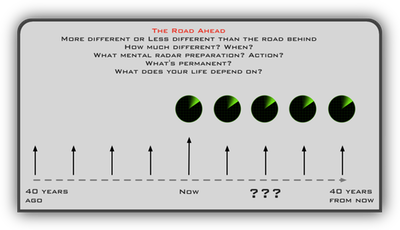
It has to build in organized abandonment of everything it does.
It has to learn to ask every few years of every process, every product, every procedure, every policy: “If we did not do this already, would we go into it now, knowing what we now know?”
And if the answer is no, the organization has to ask: “And what do we do now?”
It has to do something, not just make another study.
Increasingly, organizations will have to plan abandonment rather than try to prolong the life of a successful policy, practice, or product—something which so far only a few large Japanese companies have faced up to.
On this, see Chapter 24, “The New Japanese Business Strategies,” in Managing for the Future (1992).
But the ability to create the new also has to be built into the organization.
Specifically, each organization has to build into its very fabric three systematic practices.
First, each organization requires continuing improvement of everything it does—the process the Japanese call Kaizen.
Every artist throughout history has practiced Kaizen, that is, organized, continuous self-improvement.
But only the Japanese so far (perhaps because of their Zen tradition) have embodied it in the daily life and work of their business organizations—although not yet into their singularly change-resistant universities.
The aim of Kaizen is to improve each product or service so that it becomes a truly different product or service in two or three years’ time.
Every organization will secondly have to learn to exploit, that is, to develop new applications from its own successes.
Again, Japanese businesses have done the best job in this so far, as witness the way in which the Japanese consumer electronics manufacturer has developed one new product after the other out of the same American invention, the tape recorder.
But building on their successes is also one of the strengths of the American “pastoral” churches, whose fast growth is beginning to offset the steady decline of both the traditional “Social Christianity” and the traditional fundamentalist churches.
Every organization, third, will have to learn how to innovate and to learn that innovation can and should be organized as a systematic process.
See Purposeful innovation in Innovation and Entrepreneurship (the book)
Then of course one comes back to abandonment and the whole process starts all over again.
Unless these tasks are systematically carried out, the knowledge-based, post-capitalist organization will very soon find itself obsolescent.
It soon will lose performance capacity, and with it the ability to attract and to hold the knowledge specialists on whom it depends.
There is a further implication: post-capitalist society has to be decentralized.
Its organizations must be able to make fast decisions, based on closeness to performance, closeness to the market, closeness to technology, closeness to the changes in society, environment, and demographics, all of which must be seen and utilized as opportunities for innovation.
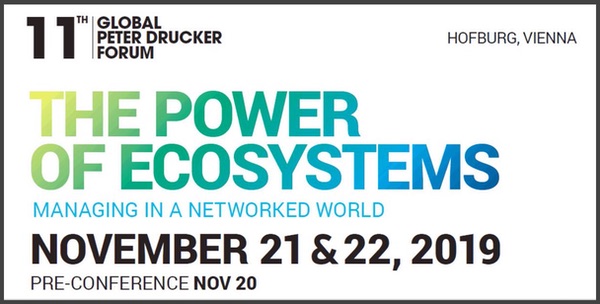
T. George Harris ::: Post-capitalist executive
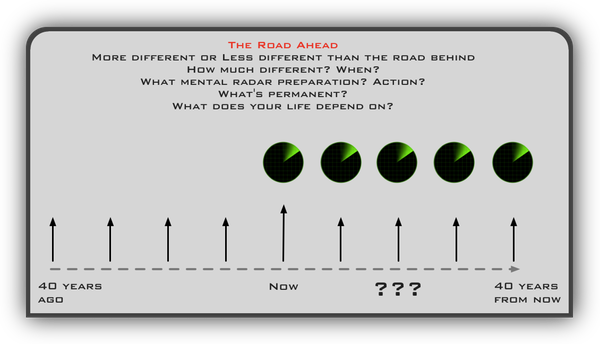
Organizations in the post-capitalist society thus constantly upset, disorganize, and destabilize the community.
They must change the demand for skills and knowledges.
Just when every technical university is geared up to teach physics, geneticists are what we need.
Just when the banks have organized credit analysis, they need investment people.
Companies on which local communities depend for employment close their factories, or replace grizzled model makers who have spent years learning their craft with twenty-five-year-old “whiz kids” who know computer simulation.
Hospitals move the delivery of babies into a freestanding “birthing center” when the knowledge base and technology of obstetrics change.
We must be ready to close down a hospital completely when changes in medical practice and technology make a center with fewer than two hundred beds uneconomical and incapable of giving first-rate care.
Similarly, for the school or the college to discharge its social function, we must be able to close down a school or a college—no matter how deeply rooted in the local community and how much loved by it—if changes in demographics, technology, or knowledge make a different size or a different philosophy a prerequisite of good performance.
But every one of such changes upsets the community, disrupts it, deprives it of continuity.
Every one is perceived as “unfair.”
Every one destabilizes.
Modern organization creates yet another tension for the community.
It has to operate in a community.
Its members live in that community, speak its language, send their children to its schools, vote in it, pay taxes to it.
They have to feel at home in it—their results are in the community.
Yet the organization cannot submerge itself in the community or subordinate itself to that community.
Its “culture” has to transcend community.
Knowledge Economy and Knowledge Polity
What Is Management? (take 3)
But what is management?
Is it a bag of techniques and tricks?
A bundle of analytical tools like those taught in business schools? These are important, to be sure, just as a thermometer and anatomy are important to the physician.
But the evolution and history of management—its successes as well as its problems—teach that management is, above all else, a very few, essential principles.
To be specific:
see chapter 2 of Management, Revised Edition by Peter Drucker …
To have a solid fundamental foundation for making future directed organizational decisions one should digest the material starting with Peter Drucker’s Legacy by Jim Collins (Good to Great) (at the very beginning of the book) through the end of chapter seven in Management, Revised Edition. (at the very beginning of the book) through the end of chapter seven in Management, Revised Edition.
Knowledge workers need to digest the chapters in Part X.
Knowledge Work As A System
Productivity of the knowledge worker will almost always require that the work itself be restructured and be made part of a system.
One example is servicing expensive equipment, such as huge and expensive earth-moving machines.
Traditionally, this had been seen as distinct and separate from the job of making and selling the machines.
But when the U.S. Caterpillar Company, the world’s largest producer of such equipment, asked, “What are we getting paid for?”
the answer was, “We are not getting paid for machinery.
We are getting paid for what the machinery does at the customer’s place of business.
That means keeping the equipment running, since even one hour during which the equipment is out of operation may cost the customer far more than the equipment itself”
In other words, the answer to “What is our business?” was “Service.”
This then led to a total restructuring of operations all the way back to the factory, so that the customer can be guaranteed continuing operations and immediate repairs or replacements.
And the service representative, usually a technologist, has become the true “decision maker.”

The same principle is demonstrated in another, seemingly very different, example.
A group of about twenty-five orthopedic surgeons in a midwestern U.S. city have organized themselves as a “system” to produce the highest-quality work:
by using optimally the limited and expensive resources of operating and recovery rooms;
by using optimally the supporting knowledge of people such as anesthesiologists or surgical nurses;
by building continuous learning and continuous innovation into the work of the entire group and of its every member;
and finally, by minimizing costs.
Each of the surgeons retains full control of his or her practice.
He or she is fully responsible for obtaining and treating the individual patient.
Traditionally, surgeons schedule surgeries early in the morning.
Hence, operating rooms and recovery rooms are standing empty most of the time.
The group now schedules the use of operating and recovery rooms for the entire group so that this scarce and extremely expensive resource is used ten hours a day.
The group, as a group, decides on the standardization of tools and equipment so as to obtain the highest quality at the lowest cost.
Finally, the group has also built quality control into its system.
Every three months, three different surgeons are designated to scrutinize every operation done by each of the members—the diagnosis, the surgery, the after-treatment.
They then sit down with the individual surgeons and discuss their performance.
They suggest where there is need for improvement.
But they may also recommend that a certain surgeon be asked to leave the group, as his or her work is not satisfactory.
And each year the quality standards that these supervising committees apply are discussed with the whole group and are raised, and often substantially.
As a result, this group now does almost four times as much work as it did before.
It has cut the costs by 50 percent, half of it by cutting back on the waste of operating and recovery rooms, half by standardizing tools and equipment.
And in such measurable areas as success rates in knee replacements or shoulder replacements, or in recovery after sports injuries, it has greatly improved its results.
What to do about knowledge-worker productivity is thus largely known.
So is how to do it.
Management’s New Paradigm
Prevailing assumptions about the realities of management determine what scholars, teachers, and executives assume to be reality.
This chapter challenges three assumptions underlying the discipline of management:
- management is business management
- there is one right organization
- there is one right way to manage people
Also challenged are four assumptions underlying the practice of management:
- technologies and end-users are fixed and given
- management’s scope is legally defined
- the inside is management’s domain
The new paradigms that supersede the three disciplinary assumptions of management are:
-
Management is the specific and distinguishing organ of any and all organizations.
-
Management must look for the organization that fits the task.
-
One does not “manage” people. The task is to lead people and make productive the specific strengths and knowledge of each individual.
The new paradigms that supersede the four practice assumptions of management are:
-
Neither technology nor end-use of a product is the correct foundation for management policy. Management must start with customer values and customer decisions as the basis for its strategy.
-
The scope of management is not legal; it is operational, covering the entire economic chain.
-
The practice of management will have to he defined operationally rather than by political boundaries.
-
The results of any institution exist only on the outside.
Underlying all of these is one insight:
Management is the specific tool, the specific function, the specific instrument, to make institutions capable of producing results.
This, however, requires a final new management paradigm:
Management’s concern and management’s responsibility are everything that affects the performance of the institution and its results—whether inside or outside, whether under the institution’s control or totally beyond it.
See Management’s New Paradigm PDF and table
Harmonize the Immediate and Long-range Future
A manager must, so to speak, keep his nose to the grindstone while lifting his eyes to the hills—quite an acrobatic feat.
A manager has two specific tasks.
The first is creation of a true whole that is larger than the sum of its parts, a productive entity that turns out more than the sum of the resources put into it.
The second specific task of the manager is to harmonize in every decision and action the requirements of the immediate and of the long-range future.
A manager cannot sacrifice either without endangering the enterprise.
If a manager does not take care of the next hundred days, there will be no next hundred years.
Whatever the manager does should be sound in expediency as well as in basic long-range objective and principle.
And where he cannot harmonize the two time dimensions, he must at least balance them.
He must calculate the sacrifice he imposes on the long-range future of the enterprise to protect its immediate interests, or the sacrifice he makes today for the sake of tomorrow.
He must limit either sacrifice as much as possible.
And he must repair as soon as possible the damage it inflicts.
He lives and acts in two time dimensions, and is responsible for the performance of the whole enterprise and of his own component in it.
From Sep 28 in The Daily Drucker
originally from
Management: Tasks, Responsibilities, Practices
Creating a True Whole
Create a true whole greater than the sum of its parts.
A manager has the task of creating a true whole that is larger than the sum of its parts.
One analogy is the task of the conductor of a symphony orchestra, through whose effort, vision, and leadership individual instrumental parts become the living whole of a musical performance.
But the conductor has the composer's score; he is only interpreter.
The manager is both composer and conductor.
The task of creating a genuine whole also requires that the manager, in every one of her acts, consider simultaneously the performance and results of the enterprise as a whole and the diverse activities needed to achieve synchronized performance.
It is here, perhaps, that the comparison with the orchestra conductor fits best.
A conductor must always hear both the whole orchestra and, say, the second oboe.
Similarly, a manager must always consider both the overall performance of the enterprise and, say, the market research activity needed.
By raising the performance of the whole, she creates scope and challenge for market research.
By improving the performance of market research, she makes possible better overall business results.
The manager must simultaneously ask two double-barreled questions:
"What better business performance is needed and what does this require of what activities?"
And "What better performances are the activities capable of and what improvement in business results will they make possible?"
From Mar 7 in The Daily Drucker
originally from
Management: Tasks, Responsibilities, Practices
Connect to Peter Drucker Social Political Ecologist
There is one fundamental insight underlying all management science.
It is that the business enterprise is a system of the highest order: a system the parts of which are human beings contributing voluntarily of their knowledge, skill, and dedication to a joint venture.
And one thing characterizes all genuine systems, whether they be mechanical, like the control of a missile, biological like a tree, or social like the business enterprise:
it is interdependence.
The whole of a system is not necessarily improved if one particular function or part is improved or made more efficient.
In fact, the system may well be damaged thereby, or even destroyed.
In some cases the best way to strengthen the system may be to weaken a part—to make it less precise or less efficient.
For what matters in any system is the performance of the whole; this is the result of growth and of dynamic balance, adjustment, and integration rather than of mere technical efficiency
Management: Tasks, Responsibilities, Practices
Connect to Peter Drucker Social Political Ecologist
Almost 30 years ago, John Bachmann, then the managing partner of the investment firm Edward Jones, wrote a blind letter to Peter Drucker.
He was anxious to meet.
“What do I have to do to get you to sit down…[and] relate your philosophy of business to our company?” Bachmann asked.
He noted that he and his team had read Drucker’s 1973 classic, Management: Tasks, Responsibilities, Practices, so many times that “our copies are literally worn out,” but since “we are basically salesmen, we continue to have difficulty understanding some of your ideas.”
Drucker was hooked.
And in early 1982, he began consulting for Edward Jones.
As Drucker followed up in the memo shown here, he endeavored to be concise:
“I did not want to write another book—you are badly infested with Drucker books anyhow, I would say.”
Still, Drucker touched on several themes from their initial meeting, including the need for Edward Jones to harness its unique character.
“Stop talking about “Druckerizing” your organization,” Drucker demanded.
“The job ahead of you is to ‘Jonesize’ your organization—and only if you accept this would I be of any help to you.”
Clearly, Bachmann and his team were able to “Jonesize” the firm.
Today, Edward Jones serves nearly 7 million clients and has more offices than any other investment firm in America.
The Role of the Social Sector
Most people think of Peter Drucker as the “father of modern management,” which he was (though he was never very comfortable with that description).
And while it’s true that most of the very successful corporations owe a lot of their success to him, Peter increasingly turned his attention to the social sector—nonprofit organizations whose role is to look after the social needs of a culture.
Peter felt strongly that while government has a critical role to play as policy maker, standard setter, and paymaster, it should not attempt to run social services because it has proven to be almost totally incompetent in that area.
He also believed it was not a primary role of business to provide for the social needs of citizens.
Instead, nonprofit agencies—of which more than fifty percent are churches and faith-based organizations—have the greatest potential for doing the greatest good.
But as Peter would often say, “Don’t mistake potential for performance,” and devoted a great deal of his time helping the social sector, including churches, becoming more effective by becoming better managers.
I know that some have criticized larger churches for becoming more “businesslike” by adopting modern management principles, but Peter was adamant that the function of management is to make the church more churchlike, not make it more businesslike.
He saw such huge potential within churches to care for the social needs of the nation, especially within the ranks of Baby Boomers who will be looking for more meaningful options to retirement.
From Halftime by Bob Buford
“I see functioning societies as a bulwark against the threat of totalitarianism, and they depend on management for their performance.
The present tendency to look at management by itself is nonsense.
Management exists for the sake of an organization.
It is the servant of the organization.
And any management that forgets that is mismanagement and will lead their organization down pretty fast—misleaders destroy their organization.
Management and administrators are servants.”
— Peter Drucker, 2004 radio interview with Tom Ashbrook. Joe’s Journal
A Century of Social Transformation
Because the knowledge society perforce has to be a society of organizations, its central and distinctive organ is management.
When we first began to talk of management, the term meant “business management” —since large-scale business was the first of the new organizations to become visible.
But we have learned this last half-century that management is the distinctive organ of all organizations.
All of them require management—whether they use the term or not.
All managers do the same things whatever the business of their organization.
All of them have to bring people—each of them possessing a different knowledge—together for joint performance.
All of them have to make human strengths productive in performance and human weaknesses irrelevant.
All of them have to think through what are “results” in the organization—and have then to define objectives.
All of them are responsible to think through what I call the “theory of the business,” that is, the assumptions on which the organization bases its performance and actions, and equally, the assumptions which organizations make to decide what things not to do.
All of them require an organ that thinks through strategies, that is, the means through which the goals of the organization become performance.
All of them have to define the values of the organization, its system of rewards and punishments, and with its spirit and its culture.
In all of them, managers need both
the knowledge of management as work and discipline,
and the knowledge and understanding of the organization itself, its purposes, its values, its environment and markets, its core competencies. — A Century of Social Transformation by Peter Drucker
Managing Service Institutions in the Society of Organizations
From Chapter 12 of Management, Revised Edition
 
Amazon Links: Management Rev Ed and Management Cases, Revised Edition and Management Cases, Revised Edition
Business enterprise is only one of the institutions of modern society, and business managers are by no means our only managers.
Service institutions are equally institutions and, therefore, equally in need of management.
Some of the most familiar of these institutions are government agencies, the armed services, schools, colleges, universities, research laboratories, hospitals and other health-care institutions, unions, professional practices such as the large law firm, and professional, industry, and trade associations.
They all have people who are paid for doing the management job, even though they may be called administrators, commanders, directors, or executives, rather than managers.
The Multi-Institutional Society
Public-service institutions are supported by the economic surplus produced by economic activity.
They are social overhead.
The growth of the public service institution in the twentieth and twenty-first centuries is the best testimonial to the success of business in discharging its economic task—producing economic surplus.
Yet, unlike the early nineteenth-century university, the service institutions are not a luxury or an ornament.
They are essentials of a modern society.
They have to perform if society and business are to function.
These service institutions are the main expense of a modern society.
Approximately half of the gross national product of the United States (and of most of the other developed countries) is spent on public-service institutions.
Every citizen in the developed, industrialized, urbanized societies depends for survival on the performance of the public-service institutions.
These institutions also embody the values of developed societies.
Education, health care, knowledge, and mobility—not just more food, clothing, and shelter—are the fruits of our society's increased economic capacities and productivity.
Yet the evidence for performance in the service institutions is not impressive, let alone overwhelming.
Colleges, hospitals, and universities have grown larger than an earlier generation would have dreamed possible.
Their budgets have grown even faster.
Yet everywhere they are in crisis.
A generation or two ago their performance was taken for granted.
Today they are attacked on all sides for lack of performance.
Services that the nineteenth century managed successfully with little apparent effort—the postal service, for instance, or the railroads—are today deep in the red and require enormous subsidies.
National and local government agencies are constantly being reorganized for efficiency.
Yet in every country citizens complain loudly of growing bureaucracy in government.
What they mean is that the government agency is being run more for the convenience of its employees than for contribution and performance.
This is mismanagement.
Are Service Institutions Managed?
The service institutions themselves have become "management conscious."
Increasingly they turn to business to learn management.
In all service institutions, manager development, management by objectives, and many other concepts and tools of business management are now common.
This is a healthy sign, but it does not mean that the service institutions understand the problems of managing themselves.
It only means that they begin to realize that at present they are not being managed.
But Are They Manageable?
There is another and very different response to the performance crisis of the service institutions.
A growing number of critics have come to the conclusion that service institutions are inherently unmanageable and incapable of performance.
Some go so far as to suggest that they should, therefore, be dissolved.
But there is not the slightest evidence that today's society is willing to do without the contributions the service institutions provide.
The people who most vocally attack the shortcomings of the hospitals want more and better health care.
Those who criticize public schools want better, not less, education.
The voters bitterest about government bureaucracy vote for more government programs.
We have no choice but to learn to manage the public-service institutions for performance.
And they can be managed for performance.

Managing Public-Service Institutions For Performance
Different classes of service institutions need different structures.
But all of them need first to impose on themselves discipline of the kind imposed by leaders of the institutions in the examples in the previous chapters.
This work involves
attention-directing and
mental patterns
 They need to define "what our business is and what it should be." They need to define "what our business is and what it should be."
See "The Theory of the Business" in chapter 8 of Management, Revised Edition and The Five Most Important Questions You Will Ever Ask About Your Organization (converts intentions into action)
 They need to bring alternative definitions into the open and consider them carefully. They need to bring alternative definitions into the open and consider them carefully.
They should perhaps even work out some balance between the different and conflicting definitions of mission (as did the presidents of the emerging American universities—see later in this chapter).
 They must derive clear objectives and goals from their definition of function and mission. They must derive clear objectives and goals from their definition of function and mission.
 They then must set priorities that enable them to select targets, to set standards of accomplishment and performance—that is, to define the minimum acceptable results, to set deadlines, to go to work on results, and to make someone accountable for results. They then must set priorities that enable them to select targets, to set standards of accomplishment and performance—that is, to define the minimum acceptable results, to set deadlines, to go to work on results, and to make someone accountable for results.
 They must define measurements of performance—customer-satisfaction measurements for the performance of Medicare services, or the number of households supplied with electric power (a quantity much easier to measure). They must define measurements of performance—customer-satisfaction measurements for the performance of Medicare services, or the number of households supplied with electric power (a quantity much easier to measure).
 They must use these measurements to feed back on their efforts. They must use these measurements to feed back on their efforts.
That is, they must build self-control by results into their system.
 Finally, they need an organized review of objectives and results, to weed out those objectives that no longer serve a purpose or have proven unattainable. Finally, they need an organized review of objectives and results, to weed out those objectives that no longer serve a purpose or have proven unattainable.
They need to identify unsatisfactory performance and activities that are outdated or unproductive, or both.
And they need a mechanism for dropping such activities rather than wasting money and human energies where the results are poor.
The last requirement may be the most important one.
Without a market test, the service institution lacks the built-in discipline that forces a business eventually to abandon yesterday—or else go bankrupt.
Assessing and abandoning low-performance activities in service institutions, outside and inside business, would be the most painful but also the most beneficial improvement.
As the examples have shown, no success is "forever."
Yet it is even more difficult to abandon yesterday's success than it is to reappraise a failure.
A once-successful project gains an air of success that outlasts the project's real usefulness and disguises its failings.
In a service institution particularly, yesterday's success becomes "policy," "virtue," "conviction," if not holy writ.
The institution must impose on itself the discipline of thinking through its mission, its objectives, and its priorities, and of building in feedback control from results and performance on policies, priorities, and action.
Otherwise, it will gradually become less and less effective.
We are in such a welfare mess today in the United States largely because the welfare program of the 1930s was such a success.
We could not abandon it and, instead, misapplied it to the radically different problem of the inner-city poor.
To make service institutions perform, it should by now be clear, does not require great leaders.
It requires a system.
The essentials of this system are not too different from the essentials of performance in a business enterprise, but the application will be quite different.
The service institutions are not businesses; performance means something quite different in them.
The applications of the essentials differ greatly for different service institutions.
As our later examples will show, there are at least three different kinds of service institutions—institutions that are not paid for performance and results, but for efforts and programs.
 How to guarantee non-performance How to guarantee non-performance
 Management by Objectives — a user’s guide Management by Objectives — a user’s guide
Entrepreneurship in the Public-Service Institution
From Chapter 16 of Management, Revised Edition
 
Public-service institutions—such as government agencies, labor unions, churches, universities and schools, hospitals, community and charitable organizations, professional and trade associations, and the like—need to be entrepreneurial and innovative fully as much as any business does.
Indeed, they may need it more.
The rapid changes in today’s society, technology, and economy are simultaneously an even greater threat to them and an even greater opportunity.
Yet public-service institutions find it far more difficult to innovate than does even the most “bureaucratic” company.
The “existing” seems to be even more of an obstacle for them.
To be sure, every service institution likes to get bigger.
In the absence of a profit test, size is the one criterion of success for a service institution, and growth a goal in itself.
And then, of course, there is always so much more that needs to be done.
But stopping what has “always been done” and doing something new are equally anathema to service institutions, or at least excruciatingly painful to them.
Most innovations in public-service institutions are imposed on them either by outsiders or by catastrophe.
The modern university, for instance, was created by a total outsider, the Prussian diplomat Wilhelm von Humboldt.
He founded the University of Berlin in 1809, when the traditional university of the seventeenth and eighteenth century had been all but completely destroyed by the French Revolution and the Napoleonic wars.
Sixty years later, the modern American university came into being, when the country’s traditional colleges and universities were dying and could no longer attract students.
Similarly, all basic innovations in the military in the twentieth century, whether in structure or in strategy, have followed on ignominious malfunction or crushing defeat:
the reorganization of the American army and of its strategy by a New York lawyer, Elihu Root, Teddy Roosevelt’s secretary of war, after its disgraceful performance in the Spanish-American War;
the reorganization, a few years later, of the British army and its strategy by Secretary of War Lord Haldane, another civilian, after the equally disgraceful performance of the British in the Boer War; and
the rethinking of the German army’s structure and strategy after the defeat of World War I.
And in government, one of the greatest examples of innovative thinking in recent political history, America’s New Deal of 1933-1936, was triggered by a Depression so severe as to almost unravel the country’s social fabric.
Critics of bureaucracy blame the resistance of public-service institutions to entrepreneurship and innovation on “timid bureaucrats,” on time-servers who “have never met a payroll,” or on “power-hungry politicians.”
It is a very old litany—in fact, it was already hoary when Machiavelli chanted it almost 500 years ago.
The only thing that changes is who intones it.
At the beginning of the twentieth century, it was the slogan of the so-called liberals and now it is the slogan of the so-called neoconservatives.
Alas, things are not that simple, and “better people” that perennial panacea of reformists—is a mirage.
The most entrepreneurial, innovative people behave like the worst time-serving bureaucrat or power-hungry politician six months after they have taken over the management of a public-service institution, particularly if it is a government agency.
The forces that impede entrepreneurship and innovation in a public-service institution are inherent in it, integral to it, inseparable from it.
The best proof of this are the internal staff services in businesses, which are, in effect, the “public-service institutions” within business corporations.
These are typically headed by people who have come out of operations and have proven their capacity to perform in competitive markets.
And yet, the internal staff services are not notorious as innovators.
They are good at building empires—and they always want to do more of the same.
They resist abandoning anything they are doing.
But they rarely innovate once they have been established.
There are three main reasons why the existing enterprise presents so much more of an obstacle to innovation in the public-service institution than it does in the typical business enterprise.
First, the public-service institution is based on a “budget” rather than on being paid out of its results.
It is paid for its efforts and out of funds somebody else has earned, whether the taxpayer, the donors of a charitable organization, or the company for which a human resource department or the marketing services staff work.
The more efforts the public-service institution engages in, the greater its budget will be.
And “success” in the public-service institution is defined by getting a larger budget rather than obtaining results.
Any attempt to slough off activities and efforts, therefore, diminishes the public-service institution.
It causes it to lose stature and prestige.
Failure cannot be acknowledged.
Worse still, the fact that an objective has been attained cannot be admitted.
A service institution is dependent on a multitude of constituents.
In a business that sells its products on the market, one constituent, the consumer, eventually overrides all the others.
A business needs only a very small share of a small market to be successful.
Then it can satisfy the other constituents, whether they are shareholders, workers, the community, and so on.
But precisely because public-service institutions—and that includes the staff activities within a business corporation—have no “results” out of which they are being paid, any constituent, no matter how marginal, has, in effect, a veto power.
A public-service institution has to satisfy everyone; certainly, it cannot afford to alienate anyone.
The moment a service institution starts an activity, it acquires a “constituency,” which then refuses to have the program abolished or even significantly modified.
But anything new is always controversial.
This means that it is opposed by existing constituencies without having formed, as yet, a constituency of its own to support it.
The most important reason, however, is that public-service institutions exist, after all, to “do good.”
This means that they tend to see their mission as a moral absolute rather than as economic and subject to a cost-benefit calculus.
Economics always seeks a different allocation of the same resources to obtain a higher yield.
Everything economic is therefore relative.
In the public-service institution, there is no such thing as a higher yield.
If one is “doing good,” then there is no “better.”
Indeed, failure to attain objectives in the quest for a “good” only means that efforts need to be redoubled.
The forces of evil must be far more powerful than expected and need to be fought even harder.
For thousands of years the preachers of all sorts of religions have held forth against the “sins of the flesh.”
Their success has been limited to say the least.
But this is no argument as far as the preachers are concerned.
It does not persuade them to devote their considerable talents to pursuits in which results may be more easily attainable.
On the contrary, it only proves that their efforts need to be redoubled.
Avoiding the “sins of the flesh” is clearly a “moral good,” and thus an absolute, which does not admit to any cost-benefit calculation.
Few public-service institutions define their objectives in such absolute terms.
But even company human resource departments and manufacturing service staffs tend to see their mission as “doing good,” and therefore as being moral and absolute instead of being economic and relative.
This means that public-service institutions are out to maximize rather than to optimize.
“Our mission will not be completed,” asserts the head of the Crusade Against Hunger, “as long as there is one child on the earth going to bed hungry.”
If he were to say, “Our mission will be completed if the largest possible number of children that can be reached through existing distribution channels get enough to eat not to be stunted,” he would be booted out of office.
But if the goal is maximization, it can never be attained.
Indeed, the closer one comes to attaining one’s objective, the more efforts are called for.
For, once optimization has been reached (perhaps between 75 and 80 percent of theoretical maximum), additional costs go up exponentially while additional results fall off exponentially.
The closer a public-service institution comes to attaining its objectives, therefore, the more frustrated it will be and the harder it will work on what it is already doing.
It will, however, behave exactly the same way the less it achieves.
Whether it succeeds or fails, the demand to innovate and to do something else will be resented as an attack on its basic commitment, on the very reason for its existence, and on its beliefs and values.
The Need to Innovate
Why is innovation in the public-service institution so important?
Why can we not leave existing public-service institutions the way they are and depend on new institutions for the innovations we need in the public-service sector, as historically we have always done?
The answer is that public-service institutions have become too important in developed countries, and too big.
The public-service sector, both the governmental one and the nongovernmental but not-for-profit one, has grown faster during the twentieth century than the private sector—maybe three to five times as fast.
The growth has been especially fast since World War II.
To some extent, this growth has been excessive.
Wherever public-service activities can be converted into profit-making enterprises, they should be so converted.
This applies to not only the kind of municipal services the city of Lincoln, Nebraska, now privatizes.
The move from nonprofit to profit has already gone very far in the American hospital.
It may become a stampede in professional and graduate education.
To subsidize the highest earners in developed society—the holders of advanced professional degrees—can hardly be justified.
A central economic problem of developed societies is capital formation.
We therefore can ill afford to have activities conducted as “nonprofit”—that is, as activities that devour capital rather than form it—if they can be organized as activities that form capital, as activities that make a profit.
But the great bulk of the activities that are being discharged in and by public-service institutions will still remain public-service activities, and will neither disappear nor be transformed.
Consequently, they have to be made producing and productive.
Public-service institutions will have to learn to be innovators, to manage themselves entrepreneurially.
To achieve this, public-service institutions will have to learn to look upon social, technological, economic, and demographic shifts as opportunities in a period of rapid change in all these areas.
Otherwise, they will become obstacles.
Such public-service institutions will increasingly become unable to discharge their mission as they adhere to programs and projects that cannot work in a changed environment, and yet they will not be able or willing to abandon the missions they can no longer discharge.
Increasingly, they will come to look the way the feudal barons came to look after they had lost all social function around 1300:
as parasites, functionless, with nothing left but the power to obstruct and to exploit.
They will become self-righteous while increasingly losing their legitimacy.
Clearly, this is already happening to the apparently most powerful among them, the labor union.
Yet a society in rapid change, with new challenges, new requirements and opportunities, needs public-service institutions.
The public school in the United States exemplifies both the opportunities and the dangers.
Unless it takes the lead in innovation, it is unlikely to survive, except as a school for the minorities in the slums as parents of middle- and high-income families send their children to private and parochial schools.
For the first time in its history, the United States faces the threat of a class structure in education in which all but the very poor remain outside of the public school system—at least in the cities and suburbs where most of the population lives.
And this will squarely be the fault of the public school itself, because what is needed to reform the public school is already known.
Many other public-service institutions face a similar situation.
The knowledge is there.
The need to innovate is clear.
They now have to learn how to build entrepreneurship and innovation into their own system.
Otherwise, they will find themselves superseded by outsiders who will create competing entrepreneurial public-service institutions and so render the existing ones obsolete.
The late nineteenth century and early twentieth century was a period of tremendous creativity and innovation in the public-service field.
Social innovation during the seventy-five years until the 1930s was surely as much alive, as productive, and as rapid as technological innovation, if not more so.
But in these periods the innovation took the form of creating new public-service institutions.
The need for social innovation may be even greater now, but it will very largely have to be social innovation within the existing public-service institution.
To build entrepreneurial management into the existing public-service institution may thus be the foremost political task of this generation.

What is a business?
To know what a business is, we have to start with its purpose.
Its purpose must lie outside of the business itself.
In fact, it must lie in society, since business enterprise is an organ of society.
There is only one valid definition of business purpose: to create a customer.
Markets are not created by God, nature, or economic forces but by executives.
The want a business satisfies may have been felt by the customer before he was offered the means of satisfying it.
Like food in a famine, it may have dominated the customer's life and filled all his waking moments, but it remained a potential want until the action of businessmen converted it into effective demand.
Only then is there a customer and a market.
The want may have been unfelt by the potential customer; no one knew that he wanted a photocopier or a computer until these became available.
There may have been no want at all until business action created it—by innovation, by credit, by advertising, or by salesmanship.
In every case, it is business action that creates the customer.
It is the customer who determines what a business is.
It is the customer alone whose willingness to pay for a good or for a service converts economic resources into wealth, things into goods.
What the customer buys and considers value is never a product.
It is always utility, that is, what a product or a service does for him.
Because its purpose is to create a customer, the business enterprise has two—and only these two—basic functions: marketing and innovation. (calendarize this?)
Despite the emphasis on marketing and the marketing approach, marketing is still rhetoric rather than reality in far too many businesses.
Consumerism proves this.
When managers speak of marketing, they usually mean the organized performance of all selling functions.
This is still selling.
It still starts out with “our products.”
It still looks for “our market.”
True marketing starts out the way Marks & Spencer starts out, with the customer, his demographics, his realities, his needs, his values.
It does not ask, “What do we want to sell?”
It asks, “What does the customer want to buy?”
It does not say, “This is what our product or service does.”
It says, “These are the satisfactions the customer looks for, values and needs.
Marketing alone does not make a business enterprise.
In a static economy, there are no business enterprises.
There are not even executives.
The middleman of a static society is a broker who receives his compensation in the form of a fee, or a speculator who creates no value.
A business enterprise can exist only in an expanding economy, or at least in one that considers change both natural and acceptable.
And business is the specific organ of growth, expansion, and change.
The second function of a business is, therefore, innovation—the provision of different economic satisfactions.
It is not enough for the business to provide just any economic goods and services; it must provide better and more economic ones.
It is not necessary for a business to grow bigger; but it is necessary that it constantly grow better.
… Social problems, such as a deteriorating educational system, by contrast, are dysfunctions of society rather than impacts of the organization and its activities.
Since the institution can exist only within the social environment and is indeed an organ of society, such social problems affect the institution.
They are of concern to it even if … the company had no role in producing the decline in the education system.
A healthy business, a healthy university, a healthy hospital cannot exist in a sick society.
Management has a self-interest in a healthy society, even though the cause of society's sickness is not of management's making. (calendarize this?)
Management, Revised Edition

Changing Values and Characteristics
From chapter 19 of Innovation and Entrepreneurship by Peter Drucker

Amazon link: Innovation and Entrepreneurship
In the entrepreneurial strategies discussed so far, the aim is to introduce an innovation.
In the entrepreneurial strategy discussed in this chapter, the strategy itself is the innovation.
The product or service it carries may well have been around a long time—in our first example, the postal service, it was almost two thousand years old.
But the strategy converts this old, established product or service into something new.
It changes its utility, its value, its economic characteristics.
While physically there is no change, economically there is something different and new.
All the strategies to be discussed in this chapter have one thing in common.
They create a customer — and that is the ultimate purpose of a business, indeed, of economic activity.
As was first said more than thirty years ago in my The Practice of Management (New York: Harper & Row, 1954).
But they do so in four different ways:
 by creating utility by creating utility
 by pricing by pricing
 by adaptation to the customer’s social and economic reality by adaptation to the customer’s social and economic reality
 by delivering what represents true value to the customer by delivering what represents true value to the customer
... snip, snip ...
These examples are likely to be considered obvious.
Surely, anybody applying a little intelligence would have come up with these and similar strategies?
But the father of systematic economics, David Ricardo, is believed to have said once, “Profits are not made by differential cleverness, but by differential stupidity.”
The strategies work, not because they are clever, but because most suppliers—of goods as well as of services, businesses as well as public-service institutions—do not think.
They work precisely because they are so “obvious.”
Why, then, are they so rare?
For, as these examples show, anyone who asks the question, What does the customer really buy? will win the race.
In fact, it is not even a race since nobody else is running.
What explains this?
One reason is the economists and their concept of “value.”
Every economics book points out that customers do not buy a “product,” but what the product does for them.
And then, every economics book promptly drops consideration of everything except the “price” for the product, a “price” defined as what the customer pays to take possession or ownership of a thing or a service.
What the product does for the customer is never mentioned again.
Unfortunately, suppliers, whether of products or of services, tend to follow the economists.
It is meaningful to say that “product A costs X dollars.”
It is meaningful to say that “we have to get Y dollars for the product to cover our own costs of production and have enough left over to cover the cost of capital, and thereby to show an adequate profit.”
But it makes no sense at all to conclude and therefore the customer has to pay the lump sum of Y dollars in cash for each piece of product A he buys.”
Rather, the argument should go as follows: “What the customer pays for each piece of the product has to work out as Y dollars for us.
But how the customer pays depends on what makes the most sense to him.
It depends on what the product does for the customer.
It depends on what fits his reality.
It depends on what the customer sees as ‘value.’”
Price in itself is not “pricing,” and it is not “value.”
It was this insight that gave King Gillette a virtual monopoly on the shaving market for almost forty years; it also enabled the tiny Haloid Company to become the multibillion-dollar Xerox Company in ten years, and it gave General Electric world leadership in steam turbines.
In every single case, these companies became exceedingly profitable.
But they earned their profitability.
They were paid for giving their customers satisfaction, for giving their customers what the customers wanted to buy, in other words, for giving their customers their money’s worth.
“But this is nothing but elementary marketing,” most readers will protest, and they are right.
It is nothing but elementary marketing.
To start out with the customer’s utility, with what the customer buys, with what the realities of the customer are and what the customer’s values are—this is what marketing is all about.
But why, after forty years of preaching Marketing, teaching Marketing, professing Marketing, so few suppliers are willing to follow, I cannot explain.
The fact remains that so far, anyone who is willing to use marketing as the basis for strategy is likely to acquire leadership in an industry or a market fast and almost without risk.
Entrepreneurial strategies are as important as purposeful innovation and entrepreneurial management.
Together, the three make up innovation and entrepreneurship.
The available strategies are reasonably clear, and there are only a few of them.
But it is far less easy to be specific about entrepreneurial strategies than it is about purposeful innovation and entrepreneurial management.
We know what the areas are in which innovative opportunities are to be found and how they are to be analyzed.
There are correct policies and practices and wrong policies and practices to make an existing business or public-service institution capable of entrepreneurship; right things to do and wrong things to do in a new venture.
But the entrepreneurial strategy that fits a certain innovation is a high-risk decision.
Some entrepreneurial strategies are better fits in a given situation, for example, the strategy that I called entrepreneurial judo, which is the strategy of choice where the leading businesses in an industry persist year in and year out in the same habits of arrogance and false superiority.
We can describe the typical advantages and the typical limitations of certain entrepreneurial strategies.
Above all, we know that an entrepreneurial strategy has more chance of success the more it starts out with the users—their utilities, their values, their realities.
An innovation is a change in market or society.
It produces a greater yield for the user, greater wealth-producing capacity for society, higher value or greater satisfaction.
The test of an innovation is always what it does for the user.
Hence, entrepreneurship always needs to be market-focused, indeed, market-driven.
Still, entrepreneurial strategy remains the decision-making area of entrepreneurship and therefore the risk-taking one.
It is by no means hunch or gamble.
But it also is not precisely science.
Rather, it is judgment.
What do customers value?
The question, What do customers value?—what satisfies their needs, wants, and aspirations—is so complicated that it can only be answered by customers themselves.
And the first rule is that there are no irrational customers.
Almost without exception, customers behave rationally in terms of their own realities and their own situation. (Their logic bubble — see below)
Leadership should not even try to guess at the answers but should always go to the customers in a systematic quest for those answers.
I practice this.
Each year I personally telephone a random sample of fifty or sixty students who graduated ten years earlier.
I ask, “Looking back, what did we contribute in this school?
What is still important to you?
What should we do better?
What should we stop doing?”
And believe me, the knowledge I have gained has had a profound influence.
What does the customer value? may be the most important question.
Yet it is the one least often asked.
Nonprofit leaders tend to answer it for themselves.
“It’s the quality of our programs.
It’s the way we improve the community.”
People are so convinced they are doing the right things and so committed to their cause that they come to see the institution as an end in itself.
But that’s a bureaucracy.
Instead of asking, “Does it deliver value to our customers?” they ask, “Does it fit our rules?”
And that not only inhibits performance but also destroys vision and dedication.
— Peter Drucker,
The Five Most Important Questions …

Quality
Quality in a product or service is not what the supplier puts in.
It is what the customer gets out and is willing to pay for.
A product is not quality because it is hard to make and costs a lot of money, as manufacturers typically believe.
This is incompetence.
Customers pay only for what is of use to them and gives them value.
Nothing else constitutes quality.
— Peter Drucker

The Logic Bubble
I (Edward de Bono) created the term ‘logic bubble’ in a previous book.
When someone does something you do not like or with which you do not agree, it is easy to label that person as stupid, ignorant or malevolent.
But that person may be acting ‘logically’ within his or her ‘logic bubble’.

That bubble is made up of the perceptions, values, needs and experience of that person.
If you make a real effort to see inside that bubble and to see where that person is ‘coming from’, you usually see the logic of that person’s position.
In the school programme for teaching thinking (CoRT (Cognitive Research Trust) programme) there are tools which broaden perception so the thinker sees a wider picture and acts accordingly.
One of these tools is OPV, which encourages the thinker to ‘see the Other Person’s Point of View’.
We have numerous examples where a serious fight came to a sudden end when the combatants (who had learned the methods) decided to do an OPV on each other, a very similar process to understanding the ‘logic bubble’ of the other party.
— Edward de Bono
Freakonomics: A Rogue Economist Explores the Hidden Side of Everything (P.S.)
Communications

Bringing the World Into the Organization
All the traditional assumptions I have examined here rest on an even bigger assumption: that the domain of management is within the company.
That management's principal job is to run the organization. NOT
That, too, is no longer true.
It leads to an otherwise incomprehensible distinction between management and entrepreneurship.
It artificially divides the functions of managing and innovating.
This division makes no sense whatever.
An enterprise, whether a business or any other institution, that does not innovate and does not engage in entrepreneurship will not long survive.
That is true even of the oldest institution in the world, the Roman Catholic Church.
It is usually considered the most conservative one—and prides itself on not being given to rapid changes.
Yet, it, too, has frequently innovated and changed with the world.
It produced the Benedictines in the 5th century, when the Barbarians overran the Roman Empire; the Franciscans and Dominicans, 700 years later, when cities reemerged in the Middle Ages; the Jesuits in the 16th century, as an answer to the Protestant Reformation, and so on.
Protestantism innovates, too.
The great church historian Richard Niebuhr (1894-1962) showed in several books that any major change in society leads to the emergence of new Protestant denominations.
It is still happening.
The emergence of the Knowledge Society today has led to the explosive rise of the new, large nondenominational, pastoral "megachurches."
It has also led to an explosion in Pentecostalism, attracting largely the less educated and less upwardly mobile members of modern society while the megachurches have tended to attract knowledge workers.
What all this means for management is perfectly clear: The forces that most influence organizations come from outside the organization, not from within.
The new Catholic orders grew not because the organization required them but because events in society required them.
The Methodist movement in Protestantism exploded almost spontaneously in the late 18th century, not for reasons of theology but as a response to social depravity among the poorer classes in Britain and the U.S.
In short, these religions survived because they innovated in response to social change.
It should have been obvious from the beginning that management and entrepreneurship are only two different dimensions of the same task.
An entrepreneur who doesn't learn how to manage will not last long.
A management that does not learn to innovate will not last long.
Every institution—and not only business—must build into its day-to-day management four entrepreneurial activities that run in parallel.
One is the organized abandonment of products, services, processes, markets, distribution channels and so on that are no longer an optimal allocation of resources.
This is the first entrepreneurial discipline in any given situation.
Then any institution must organize for systematic, continuing improvement (what the Japanese call kaizen).
Then it has to organize for systematic and continuous exploitation, especially of its successes.
It has to build a different tomorrow on a proven today.
And, finally, it has to organize systematic innovation, that is, to create the different tomorrow that makes obsolete and, to a large extent, replaces even the most successful products of today in any organization.
I emphasize that these disciplines are not just desirable, they are three conditions for survival today.
These entrepreneurial tasks differ from the more conventional management roles of allocating present-day resources to present-day demands.
These entrepreneurial activities start with the outside and are focused on the outside.
But the tools we originally fashioned to bring the outside to the inside have all been penetrated by the inside focus of management.
The have turned into tools to enable management to ignore the outside.
Even worse, they are used to make management believe it can manipulate the outside and turn it to the organization's purpose.
Take marketing.
The term was coined 50 years ago to emphasize that the purpose and results of a business lie entirely outside of itself.
Marketing teaches that organized efforts are needed to bring an understanding of the outside, of society, economy and customer, to the inside of the organization and to make it the foundation for strategy and policy.
Yet marketing has rarely performed that grand task.
Instead it has become a tool to support selling.
It does not start out with "who is the customer?" but "what do we want to sell?"
It is aimed at getting people to buy the things that you want to make.
That's getting things backward.
American industry lost the fax machine business that way.
The question should be "how can I make things the customers want to buy."
Executives of any large organization—whether business enterprise, Roman Catholic diocese, university, health care institution, government agency—are woefully ignorant of the outside, as everybody knows who has worked with decisions in a large organization.
These executives must spend too much of their time and energy managing inwardly rather than managing outwardly.
The inward focus of management has been aggravated rather than alleviated in the last decades by the rise of information technology.
Information technology so far may well have done serious damage to management because it is so good at getting additional information of the wrong kind.
Based upon the 700-year-old accounting system designed to record and report inside data, information technology produces more data about the inside.
It produces practically no information about anything that goes on outside of the enterprise.
Practically every conference on information deals exclusively with how to get more inside data.
I have yet to hear of one that even raises the question: "What outside data do we need, and how do we get them?"
Management does not need more information about what is happening inside.
It needs more information on what is happening outside.
So far no one has figured out how to get meaningful outside data in any systematic form.
When it comes to outside data, we are still very largely in the anecdotal stage.
It can be predicted that the main challenge to information technology in the next 30 years will be to organize the systematic supply of meaningful outside information.
It is understandable that management began as a concern for the inside.
When the first large, modern organizations first arose—around 1870—the first and by far the most visible need was to organize the enterprise itself.
Nobody had ever done it before on that scale.
But now we know how to do that.
Growth and survival both now depend on getting the organization in touch with the outside world.
Management has become an external, not an internal, task.
For results take place outside the organization.
Inside, there are only costs.

Making human resources productive
… There is as a consequence only one satisfactory definition of management, whether we talk of a business, a government agency, or a nonprofit organization: to make human resources productive. (the contents of this book spread over decades through several stages of development)
It will increasingly be the only way to gain competitive advantage.
Of the traditional resources of the economist—land, labor, and capital—none anymore truly confers a competitive advantage.
To be sure, not to be able to use these resources as well as anyone else is a tremendous competitive disadvantage.
But every business has access to the same raw materials at the same price.
Access to money is worldwide.
And manual labor, the traditional third resource, has become a relatively unimportant factor in most enterprises.
Even in traditional manufacturing industries, labor costs are no more than 12 or 13 percent of total costs, so that even a very substantial advantage in labor costs (say a 5 percent advantage) results in a negligible competitive advantage except in a very small and shrinking number of highly labor-intensive industries (e.g., knitting woolen sweaters).
The only meaningful competitive advantage is the productivity of the knowledge worker.
And that is very largely in the hands of the knowledge worker rather than in the hands of management.
Knowledge workers will increasingly determine the shape of the successful employing organizations.
Read more …
Preface to Management, Revised Edition
Executive Jobs and Growth
You have to learn to manage in situations where you don’t have command authority, where you are neither controlled nor controlling.
That is the fundamental change.
Management textbooks still talk mainly about managing subordinates.
But you no longer evaluate an executive in terms of how many people report to him or her.
That standard doesn’t mean as much as the complexity of the job, the information it uses and generates, and the different kinds of relationships needed to do the work.
Similarly, business news still refers to managing subsidiaries.
But this is the control approach of the 1950s or 1960s.
The reality is that the multinational corporation is rapidly becoming an endangered species.
Businesses used to grow in one of two ways: from grass-roots up or by acquisition.
In both cases, the manager had control.
Today businesses grow through alliances, all kinds of dangerous liaisons and joint ventures, which, by the way, very few people understand.
This new type of growth upsets the traditional manager, who believes he or she must own or control sources and markets.
Managing in a Time of Great Change
Managerial Skills, Managerial Tasks, And Personal Skills
The corporation of tomorrow will be far more complex than that of today.
It will constitute a web of partnerships, joint ventures, alliances, outsourcing contractors, and various other kinds of associates or affiliates that is unprecedented in the current breadth and intricacy.
Each aspect of the corporation may have its own management, but the relationships among entities will certainly have to be coordinated and made to perform.
This complexity requires of the manager advanced skills and practices, both in his or her role as manager and as individual professional.
Management, Revised Edition
Citizenship Through the Social Sector
Social needs will grow in two areas.
They will grow, first, in what has traditionally been considered charity: helping the poor, the disabled, the helpless, the victims.
And they will grow, perhaps even faster, in respect to services that aim at changing the community and at changing people.
In a transition period, the number of people in need always grows.
There are the huge masses of refugees all over the globe, victims of war and social upheaval, of racial, ethnic, political, and religious persecution, of government incompetence and of government cruelty.
Even in the most settled and stable societies people will be left behind in the shift to knowledge work.
It takes a generation or two before a society and its population catch up with radical changes in the composition of the work force and in the demands for skills and knowledge.
It takes some time—the best part of a generation, judging by historical experience—before the productivity of service workers can be raised sufficiently to provide them with a "middle-class" standard of living.
The needs will grow equally—perhaps even faster—in the second area of social services, services which do not dispense charity but attempt to make a difference in the community and to change people.
Such services were practically unknown in earlier times, whereas charity has been with us for millennia.
But they have mushroomed in the last hundred years, especially in the United States.
These services will be needed even more urgently in the next decades.
One reason is the rapid increase in the number of elderly people in all developed countries, most of whom live alone and want to live alone.
A second reason is the growing sophistication of health care and medical care, calling for health care research, health care education, and for more and more medical and hospital facilities.
Then there is the growing need for continuing education of adults, and the need created by the growing number of one-parent families.
The community service sector is likely to be one of the true "growth sectors" of developed economies, whereas we can hope that the need for charity will eventually subside again.
Post-Capitalist Society

Management By Objectives And Self-Control
Calendarize this?
From chapter 8 of The Essential Drucker

Amazon Link: The Essential Drucker
Any business enterprise must build a true team and weld individual efforts into a common effort.
From chapter 25 of Management, Revised Edition
 
Amazon Links: Management Rev Ed and Management Cases, Revised Edition and Management Cases, Revised Edition
See contents of Management Cases, Revised Edition
Each member of the enterprise contributes something different, but all must contribute toward a common goal.
Their efforts must all pull in the same direction, and their contributions must fit together to produce a whole—without gaps, without friction, without unnecessary duplication of effort.
Every job in the company must be directed toward the objectives of the whole organization if the overall goals are to be achieved.
In particular, each manager's job must be focused on the success of the whole.
The performance that is expected of managers must be directed toward the performance goals of the business.
Results are measured by the contribution they make to the success of the enterprise.
Managers must know and understand what the business goals demand of them in terms of performance, and their superiors must know what contribution to demand and expect.
If these requirements are not met, managers are misdirected and their efforts are wasted.
Management by objectives requires major effort and special techniques.
In a business enterprise managers are not automatically directed toward a common goal.
On the contrary, organization, by its very nature, contains four factors that tend to misdirect:
 the specialized work of most managers the specialized work of most managers
 the hierarchical structure of management the hierarchical structure of management
 the differences in vision and work and the resultant isolation of various levels of management the differences in vision and work and the resultant isolation of various levels of management
 the compensation structure of the management group the compensation structure of the management group
To overcome these obstacles requires more than good intentions.
It requires policy and structure.
It requires that management by objectives be purposefully organized and be made the living law of the entire management group.
The Specialized Work Of Managers
An old story tells of three stonecutters who were asked what they were doing.
The first replied, "I am making a living."
The second kept on hammering while he said, "I am doing the best job of stone-cutting in the entire country."
The third one looked up with a visionary gleam in his eyes and said, "I am building a cathedral."
The third man is, of course, the true manager.
The first man knows what he wants to get out of the work and manages to do so.
He is likely to give a "fair day's work for a fair day's pay."
But he is not a manager and will never be one.
It is the second man who is the problem.
Workmanship is essential—an organization demoralizes if it does not demand of its members the highest workmanship they are capable of.
But there is always a danger that the true workman, the true professional, will believe that he is accomplishing something when, in effect, he is just polishing stones or collecting footnotes.
Workmanship must be encouraged in the business enterprise.
But it must always be related to the needs of the whole.
Most managers and career professionals in any business enterprise are, like the second man, concerned with specialized work.
A person's habits as a manager, his vision and values, are usually formed while he does functional and specialized work.
It is essential that the functional specialist develop high standards of workmanship, that he strive to be "the best stonecutter in the country."
For work without high standards is dishonest; it corrupts the worker and those around him.
Emphasis on, and drive for, workmanship produces innovations and advances in every area of management.
That managers strive to do the best job possible—to do "professional human resource management," to run "the most up-to-date plant," to do "truly scientific market research" must be encouraged.
But this striving for professional workmanship in functional and specialized work is also a danger.
It tends to divert the manager's vision and efforts from the goals of the business.
The functional work becomes an end in itself.
In far too many instances the functional managers no longer measure their performance by its contribution to the enterprise but only by professional criteria of workmanship.
They tend to appraise subordinates by their craftsmanship and to reward and to promote them accordingly.
They resent demands made for the sake of organizational performance as interference with "good engineering," "smooth production," or "hard-hitting selling."
The functional manager's legitimate desire for workmanship can become a force that tears the enterprise apart and converts it into a loose association of working groups.
Each group is concerned only with its own craft.
Each jealously guards its own "secrets."
Each is bent on enlarging its own domain rather than on building the business.
The remedy is to counterbalance the concern for craftsmanship with concern for the common goal of the enterprise.

Focus on Contribution

Amazon link: The Daily Drucker: 366 Days of Insight and Motivation for Getting the Right Things Done
The question "What should I contribute?" gives freedom because it gives responsibility.
The great majority of executives tend to focus downward.
They are occupied with efforts rather than with results.
They worry over what the organization and their superiors "owe" them and should do for them.
And they are conscious above all of the authority they "should have."
As a result, they render themselves ineffectual.
The effective executive focuses on contribution.
He looks up from his work and outward toward goals.
He asks: "What can I contribute that will significantly affect the performance and the results of the institution I serve?"
His stress is on responsibility.
The focus on contribution is the key to effectiveness:
 in a person's own work—its content, its level, its standards, and its impacts; in a person's own work—its content, its level, its standards, and its impacts;
 in his relations with others—his superiors, his associates, his subordinates; in his relations with others—his superiors, his associates, his subordinates;
 in his use of the tools of the executive such as meetings or reports. in his use of the tools of the executive such as meetings or reports.
The focus on contribution turns the executive's attention away from his own specialty, his own narrow skills, his own department, and toward the performance of the whole.
It turns his attention to the outside, the only place where there are results
September 5, The Daily Drucker
by Peter Drucker

How to Develop People
Any organization develops people; it either forms them or deforms them.
Any organization develops people; it has no choice.
It either helps them grow or it stunts them.
What do we know about developing people?
Quite a bit.
We certainly know what not to do, and those don'ts are easier to spell out than the dos.
First, one does not try to build upon people's weakness.
One can expect adults to develop manners and behavior and to learn skills and knowledge.
But one has to use people's personalities the way they are, not the way we would like them to be.
A second don't is to take a narrow and shortsighted view of the development of people.
One has to learn specific skills for a specific job.
But development is more than that: it has to be for a career and for a life. (calendarize this?)
The specific job must fit into this longer-term goal.
Another thing we know is not to establish crown princes.
Look always at performance, not at promise.
With the focus on performance and not potential, the executive can make high demands.
One can always relax standards, but one can never raise them.
Next, the executive must learn to place people's strengths. (See strengths in Managing Oneself)
In developing people the lesson is to focus on strengths.
Then make really stringent demands, and take the time and trouble (it's hard work) to review performance. (See "The Fourth Experience" in My Life as a Knowledge Worker)
Sit down with people and say: "This is what you and I committed ourselves to a year ago.
How have you done?
What have you done well?"
September 7, The Daily Drucker
by Peter Drucker

Drucker quotes from Forbes
“Managers yield to peer pressure. If a fellow CEO on the golf course says, ‘We are using this and we wouldn’t do without it,’ you have to do it too. The last twenty years have been very unsettling. Executives really don’t understand the world in they live.”
“American management has been no more fad-conscious than any other. Japanese and European managers have been just as oriented to fads.”
To Coca-Cola [KO]: “Don’t tell me that you had a wonderful meeting with me. Tell me what you’re going to do on Monday that’s different.”
To P&G in 2001 [PG]: “Your problem is that you have attained your original objectives. This, in many ways, is the most dangerous situation you can be in.”
“A success that has outlived its usefulness may in the end be more damaging than failure.”

… “All this suggests that the greatest changes are almost certainly still ahead of us.
We can also be sure that the society of 2030 will be very different from that of today, and that it will bear little resemblance to that predicted by today’s best-selling futurists.
It will not be dominated or even shaped by information technology.
IT will, of course, be important, but it will be only one of several important new technologies.
The central feature of the Next Society, as of its predecessors, will be new institutions and new theories, ideologies, and problems.” — Managing in the Next Society


More about management
 Knowledge ::: society of organizations ::: management Knowledge ::: society of organizations ::: management
 Society of Organizations Society of Organizations
 What do you want to be remembered for? What do you want to be remembered for?
 CEO work area landscapes CEO work area landscapes
 About management — actions, principles, essence About management — actions, principles, essence
 Management and the World’s Work Management and the World’s Work
So what’s the next step? It seems to me that an informed ambition diagnosis in needed along with interest profile that forms the basis of a work approach.
Scrivener
Also see Managing Oneself.
Amazon Link: The Essential Drucker: The Best of Sixty Years of Peter Drucker’s Essential Writings on Management (Collins Business Essentials)
Amazon link: The Daily Drucker: 366 Days of Insight and Motivation for Getting the Right Things Done
Amazon link: Managing the Nonprofit Organization
Amazon link: Innovation and Entrepreneurship
Peter Drucker: Conceptual Resources
about Peter Drucker — a political - social ecologist
The Über Mentor
Remembering Peter Drucker
from the November 2009 issue of The Economist
Top of the “food chain”
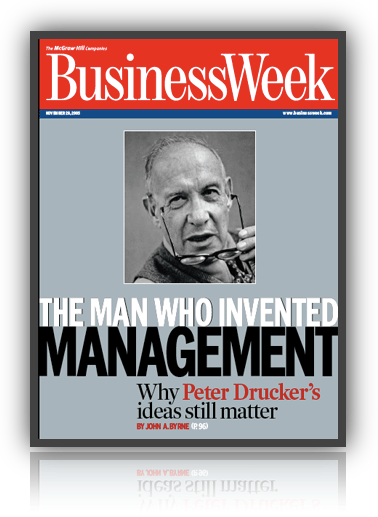

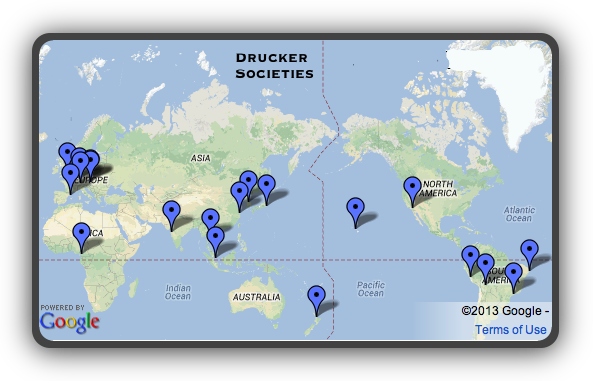
Drucker wrote several kinds of books that together create a more complete worldview. They are valuable attention directing tools. How else could your brain explore?
 The comprehensive management books provide a structural and conceptual framework. The comprehensive management books provide a structural and conceptual framework.
 The time related management books add dimensions, depth, and details. The time related management books add dimensions, depth, and details.
 The toward tomorrows and essay collections provide a backdrop of insight into situations, backgrounds, and settings in which management has an opportunity to go after results and performance. The toward tomorrows and essay collections provide a backdrop of insight into situations, backgrounds, and settings in which management has an opportunity to go after results and performance.
List of his books
Combined outline of Drucker's books — useful for topic searching.

“Rarely in human history has any institution emerged as quickly
as management or had as great an impact so fast.
In less than 150 years, management has transformed
the social and economic fabric of the world’s developed countries.
It has created a global economy and set new rules for countries
that would participate in that economy as equals.
And it has itself been transformed.
Few executives are aware of the tremendous impact
management has had” … more
“High tech is living in the nineteenth century, the pre-management world. They believe that people pay for technology. They have a romance with technology. But people don't pay for technology: they pay for what they get out of technology.” — The Frontiers of Management
“Management, that is, the “useful knowledge” that enables man for the first time to render productive people of different skills and knowledge working together in an “organization,” is an innovation of this century. It has converted modern society into something brand new, something, by the way, for which we have neither political nor social theory: a society of organizations.” — Innovation and Entrepreneurship
There is no point in asking which came first: the educational explosion of the last hundred years or the management that put this knowledge to productive use.
Modern management and modern enterprise could not exist without the knowledge base that developed societies have built.
But equally it is management, and management alone, that makes effective all this knowledge and these knowledgeable people.
The emergence of management has converted knowledge from social ornament and luxury into the true capital of any economy.
(core work toward)
The function of organizations is to make knowledges productive.
Organizations have become central to society in all developed countries because of the shift from knowledge to knowledges.
He’s not talking about your job today …
“That knowledge has become the resource,
rather than a resource,
is what makes our society “post-capitalist.”
This fact changes—fundamentally—the structure of society.
It creates new social and economic dynamics.
It creates new politics.
The post-capitalist society
is both a knowledge society and a society of organizations,
each dependent on the other and yet
each very different in its concepts, views, and values.
It is the very nature of knowledge
that it changes fast
and that today’s certainties
will be tomorrow’s absurdities.” — PFD
“AS WE ADVANCE deeper into the knowledge economy, the basic assumptions underlying much of what is taught and practiced in the name of management are hopelessly out of date.
They no longer fit reality.” — Management’s New Paradigms
“The productivity of knowledge is going to be the determining factor
in the competitive position of a company, an industry, an entire country.
No country, industry, or company has any “natural” advantage or disadvantage.
The only advantage it can possess is the ability to exploit universally available knowledge.
The only thing that increasingly will matter
in national as in international economics
is management’s performance in making knowledge productive.”
— Knowledge: Its Economics and Productivity
The world is too complex to adequately capture any topic on one page.
I have an extensive collection of conceptual resources and tools that can … These are superior to a search engine … Proof > Google: view Japan Japanese art vs. "a view of Japan through Japanese art" (in quotation marks) > Connect with : mental patterns, Peter's Principles, organization evolution, learning, personal branding, knowledge economics and productivity using my site map (below). See contact info
Other topics.
|
![]()

![]()